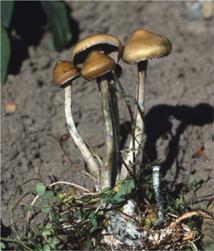

 Psilocybe azurescens (photo credits 1.136)
Psilocybe azurescens (photo credits 1.136)
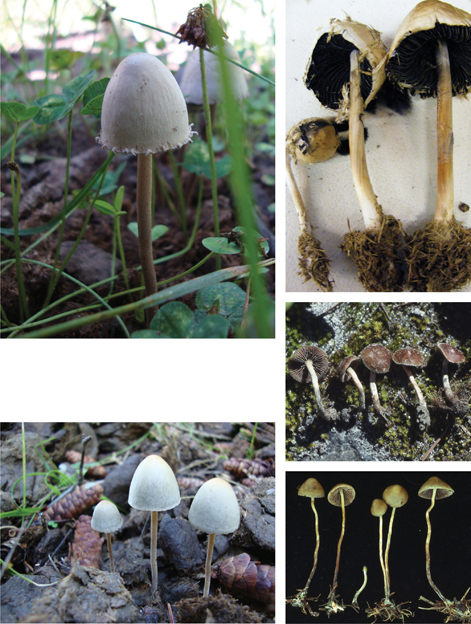
 Clockwise from above: Panaeolus sphinctrinus;
Clockwise from above: Panaeolus sphinctrinus;
Psilocybe drying; Psilocybe cyanofibrillosa;
Psilocybe pelliculosa; Panaeolus campanulatus. (photo credits 1.137)
In one experimenter, the mushroom caused dizziness, loss of coordination, unprovoked hilarity, depression, and space and time distortion.
A small species, P. angustispora, grows on marmot and elk dung in the Cascade Mountains. It is psychoactive.
The related S. coronilla may contain psilocybin, but is of dubious edibility and may be considered poisonous. Two teenagers seeking a hallucinogenic experience only received intense “bone pain” upon ingestion.
Some sources cite malaise, headache, ataxia, dizziness, vomiting, hallucinations, and confusion.
Blue green Stropharia or Psilocybin is common in the Pacific Northwest. It has a heavy layer of green slime that washes away to expose the ochre yellow cap. It has the distinct odor of fresh tomatoes.
It has not caused any poisonings in North America, or at least none reported. I wouldn’t bother.
The related P. pelliculosa and P. stuntzii are both weak to moderate psychoactive species common to the Pacific Northwest.
There are some 180 species of mushroom that contain psilocybin and/or psilocin, not all in the Psilocybe genus.
The fourth chapter of the Eiriks Saga Rautha gives a fairly detailed description of the woman named Lill-volvan, a “seeress” who travels from farm to farm predicting the future for the landowners. She was one of ten sisters who did this work. Unlike earlier Scandinavian shamanistic myths, this account is filled with intriguing mushroom motifs that are highly suggestive of Psilocybe mushroom metaphors.
The seeress is dressed in a very special way. She wears a blue cloak, jewels, and a headpiece of black lamb decorated with white cat skins, and she carries a staff. I would suggest not only that her outfit is clearly a shamanic ritual costume, but also that it serves as an entheogenic metaphor. To begin with, Lill-volvan wears a black and white fur cap. It may be merely coincidental, but the cap of … the most common and most potent of the Psilocybes found in Scandinavia is frequently black and white, as well as furry looking. The seeress also wears a blue mantle (or cloak), which immediately brings to mind the tendency of Psilocybe stems to turn blue when they are handled. Furthermore, she sits on a cushion of chicken feathers. When a mushroom is picked, one often sees white, downy material at its base, which is part of the mycelium.…
It is stated that the seeress wears a belt with mushrooms hanging from it. Moreover, on her belt hangs a pouch in which she keeps a “magical substance” that she reportedly uses in order to go into trance. It is not difficult to imagine what this substance might be.
—STEVEN LETO, SHAMAN’S DRUM (#54)
In traditional Chinese medicine, Psilocybe is used to treat Kashin-Beck disease, a form of polyarthritis believed caused by eating grain contaminated with another fungus, Fusarium sporotrichiella.
Also in traditional Chinese medicine, it is one of the main components of Pine Mushroom Elixir.
Round dung mushroom shows activity against Bacillus subtilis, S. aureus, and E. coli.
Liberty cap has been found to inhibit Staphylococcus aureus bacteria (Svay 2000).
The body apparently hydrolyzes psilocybin, the indole alkaloids, into psilocin, the bioactive compound. The psychic activity is based on interference with the neurotransmitter, serotonin, which is structurally similar to psilocin. They are also closely related to dimethyltryptamine (DMT).
Psilocin binds to the serotonergic receptor, 5HT2a, and acts as a partial agonist. That is, it stimulates some neurons and not others. The exact pathway to psychedelic experience is unknown, but one hypothesis is that an increased activity of the sensor motor gating system of the brain is involved. This system normally suppresses the majority of sensory stimuli from conscious awareness, so we can operate at a normal level.
The conscious mind is overwhelmed by sensory stimuli and cognitive processes normally hidden in the conscious part of the mind.
All species vary in their effects and due to a variety of constituents may well react differently in individuals. The species P. cubensis and P. caerulescens are found on the Gulf Coast region. The former is widely cultivated.
Paul Kroeger, one of British Columbia’s finest mycologist, notes there are ten Psilocybe species with hallucinogenic properties in that province.
Richard Haard, in Poisonous and Hallucinogenic Mushrooms, relates his experience with six different species of Psilocybe.
P. cyanescens generally lets me look into the order which my inner mind forces on the rest of me; P. semilanceata is a model builder allowing me to look into the past, present and future of my life and activities, even into the very nature of life and eternity; P. strictipes and P. baeocystis both give a visual adventure, with baeocystis the most visual mushroom thus far.
This makes sense, as P. cyanescens was found to be the most potent (thirteen milligrams per gram psilocybin plus psilocin) in a study of Pacific Northwest species. Psilocybe semilanceata (ten milligrams per gram) was second and P. stunzii (two milligrams per gram) the weakest. Variation within species varied as well, by factors from two to six.
There appears to be great bias toward mushroom species containing psilocybin. It may surprise readers to find that research by Dr. Adrian North found 12.3 percent of opera lovers have used magic mushrooms at one time or another. His research involved twenty-five hundred people.
Charles Schuster, former director of the National Institute of Drug Abuse, notes a return to the study of certain hallucinatory compounds that showed potential into the nature of human consciousness and sensory perception.
Human consciousness … is a function of the ebb and flow of neural impulses in various regions of the brain—the very substrate that drugs such as psilocybin act upon. Understanding what mediates these effects is clearly within the realm of neuroscience and deserves investigation.
A news release from Reuters, dated July 3, 2008, noted “the ‘spiritual’ effects of psilocybin from so-called sacred mushrooms last for more than a year.”
An article on the potential religious experience of states of consciousness induced by psilocybin, written by William Richards, is worth a read.
In 2006, Roland Griffiths of Johns Hopkins University in Baltimore, Maryland, and colleagues gave psilocybin to thirty-six volunteers and asked them how it felt. Most reported having a “mystical” or “spiritual” experience and rated it positively. “More than a year later, most still said the experience increased their sense of well-being or life satisfaction.”
In the same year, another study found the mushroom aborted cluster migraine headaches in twenty-two of twenty-six patients and eighteen of nineteen had extended remissions from the debilitating head pain.
Studies of psilocybin for treating schizophrenia and obsessive-compulsive disorder have been conducted.
Dr. Charles Grob of the Los Angeles Biomedical Research Institute is conducting a study to measure the effectiveness of psilocybin on the reduction of anxiety, depression, and physical pain in stage IV cancer patients.
In 2009, Johns Hopkins began recruitment for a psilocybin study involving cancer patients.
Inhibition rate against Sarcoma 180 is 80 percent and Ehrlich carcinoma cancer cells 70 percent.
The tetraprenylphenol Suillin has been identified as the principle responsible for the mushrooms cytotoxic activity. Suillin is also found in Suillus species.
Alarcon et al. found that this mushroom biotransformed 5-hydroxytryptophan to 5-hydroxy-tryptamine.
Stropharia stercoraria is a variant of S. semiglobata.
Blue green Stropharia or Psilocybin contains some interesting fats and lipids.
Early work suggests antitumor activity with inhibition of sarcoma 180 and Ehrlich carcinoma cells at 70 percent and 60 percent respectively.
Both water and ethanol extracts cause inhibition and excitation of impulse activity of neurons in the hippocampus stratum pyramidale region of the brain (Moldavan et al. 2001).
The related P. argentipes has been studied and may have application for the treatment of obsessive-compulsive disorder (Matsushima et al. 2009).
Absentminded when conversing, delusions of ants, changing suddenly, creative powers, alternately God and the devil, or in communication with God. Other delusions include possessing infinite knowledge, hearing beautiful music from a primitive source, vertigo with blurred vision, head pain, drowsiness, metallic taste in the mouth.
Dose: a proving of P. caerulescens was carried out in 1968 by David Flores Toledo, using mother tinctures of 5C, 6C, 12C, and 30C.
—VERMEULEN
Psilocybe (P. semilanceata) is for symptoms of the mind including fear of death, euphoria, feelings of unreality, withdrawn and uncommunicative, obsessive compulsive behavior, distortion of time and space, numbness and tingling of limbs, dizziness, hyper-reflexia in deep tendon reflexes, dilated pupils, blurred vision, lively colors, increased auditory acuity, flushing of neck and face, yawning, incontinence, and temporary erythema-like chest eruptions.
Dose: low potency.
—VERMEULEN
Henry Munn wrote a fascinating paper called “The Mushrooms of Language”. It can be found in Hallucinogens and Shamanism, edited by Michael Harner (Oxford University Press, 1973). In it, he writes:
Language is an ecstatic activity of signification. Intoxicated by the mushrooms, the fluency, the ease, the aptness of expression one becomes capable of are such that one is astounded by the words that issue forth from the contact of the intention of articulation with the matter of experience.… The spontaneity the mushrooms liberate is not only perceptual, but linguistic, the spontaneity of speech, of fervent, lucid discourse, of the logos in activity. For the shaman, it is as if existence were uttering itself through him.”
—HENRY MUNN
The principle gift of the psilocybin mushroom is that it allows one to commune directly with the vastly powerful intelligence that is located within all of Nature.… With psilocybinenhanced perception, I saw the trees without the usual mechanistic associations. They were no longer trees in the mundane sense, but something quite different. It was as if I were seeing for the very first time. And, once again, I was graced with the overall impression, the principal insight, that trees and plants are slowly moving organismic expressions of intelligence. Oaks manifest one kind of intelligence, pine trees another, but both are manifestations of natural intelligence.…
I am convinced that the paradigm of natural intelligence, forged in me as a result of my numerous encounters with Nature’s wilder side, could play a useful role in restoring our planet’s health and healing our dysfunctional relationship with the rest of Nature.… By encouraging extreme ecological sensitivity, psilocybin mushrooms may serve as a kind of medicinal antidote to the poisonous impact of rampant materialism. At the least, the mushrooms can show us how we have severed ourselves from the natural system of intelligence that birthed us and that still sustains our existence.
—SIMON G. POWELL
Much to my surprise and occasional dismay, I was pulled into the heaviest psychic experience I have ever encountered. I was possessed by the mushroom spirit almost as if it sought to teach me a lesson. It now seems that I was drawn into a psychoanalysis, which allowed me to act out my personal conflicts by alternately becoming the conflicting selves and always observing myself at the same time.
Something had suddenly appeared out of the creative depths of my mind, something of which I was previously unaware. I underwent an awesome, fear-filled, but enlightening experience. Without respect you may be pulled into a vortex which you have no desire to enter. If you insist on stepping through the door of ecstasy, then prepare yourself with the writing of such people as John Lilly and Carlos Castaneda.
—RICHARD HAARD
Manganese ions at two hundred micromoles increased the effect by four and twelve times respectively. A study of sixteen different polycyclic aromatic hydrocarbons found the higher molecular mass ones more easily converted (Steffen et al. 2003).
From 0.25 grams of dry mushrooms to 0.75 grams depending upon sensitivity of ingester. Up to two grams or more can be used by more experienced people.
Toxicity is very low. Therapeutic index is 641, compared to aspirin at 199 and nicotine at twenty-one. This index is a ratio of the ED50, or effective dose in 50 percent of subjects versus the LD50 that kills 50 percent of subjects.
The greatest danger is mixing them up with other LBMs, or little brown mushrooms that are lookalikes. Do not combine with MAO-inhibitors or alcohol.
Recent work suggests that the level of psilocin can vary by up to a hundred-fold when grown in dark versus light conditions. This is significant (Rafati et al. 2009).
Psilocybin mushrooms have been declared illegal by a number of countries in the last while. These include Denmark in 2001, Japan in 2002, Britain in 2005, Ireland in 2006, and Holland in 2007. Yet one more example of petty politics getting in the way of good science.
(VEILED SULFUR BOLETE)
Widely distributed, the unusual looking veiled sulfur bolete has a bright yellow cottony veil that covers both cap and stalk. It looks like a bolete, but the bright yellow, tall, and slender stalk help in identification.
In traditional Chinese medicine, it is used as one of the ingredients of Tendon Easing Powder, which is used to treat lumbago, painful legs, numbed limbs, and even tetany. The yellow powder on its surface is used to stop bleeding from any external wound.
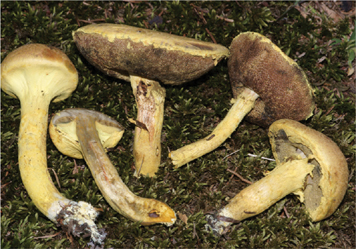
 Pulveroboletus ravenelli (photo credits 1.138)
Pulveroboletus ravenelli (photo credits 1.138)
 Vulpinic acid; two novel butenolides, isoravenelone and ravenelone; and as pulveraven A and B.
Vulpinic acid; two novel butenolides, isoravenelone and ravenelone; and as pulveraven A and B.
Duncan et al. (2003) evaluated pulveraven A and B for antimicrobial and COX anti-inflammatory activity, and on mouse mammary cultures at the University of Mississippi.
(ORANGE SPONGE POLYPORE)
Pycnoporellus is Greek meaning “countless spores.” Alboluteus is from the Latin for “yellow and white.”
Orange sponge is a soft, spongy polypore growing on the bark grooves of conifers in the Rocky Mountains.
It looks tooth-like, with its large pore openings. They can be surprisingly large considering they grow as annuals. This is a significant decomposer of conifers, starting to grow under snow in the spring.
The polypore starts out orange, then turns yellow, then white, and finally black at end of its life.
Early work by Robbins et al. (1945) found activity against Staphylococcus aureus on thiamine peptone agar.
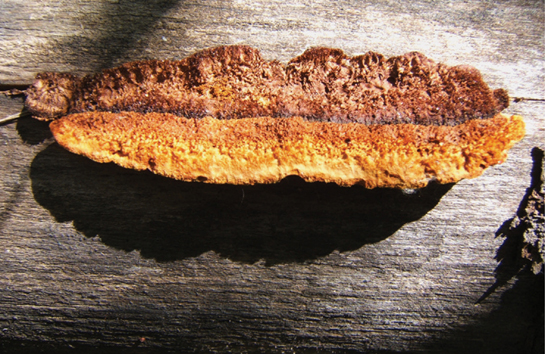
Pycnoporellus alboluteus
(see Trametes)
Truncospora demidoffii
Fomes juniperinus
P. juniperinus
Fulvifomes juniperinus
(JUNIPER POLYPORE)
This polypore looks a lot like a Phellinus conk, but only grows on juniper, and thus the species name.
Early work by Robbins et al. (1945) found activity against Staphylcoccus aureus and E. coli.
Other work found one compound, pleuromutilin, to possess antitumor activity in clinical studies. To my knowledge, no follow-up work has been conducted.
Basidioradulum orbiculare
According to David Arora, this fungi “has an irregularly lumpy or warty spore-producing surface that is distinctly reminiscent of regurgitated dog food.”
Early work by Robbins et al. (1945) found significant activity against both Staphylococcus aureus and E. coli.
Clavaria botrytis
(CLUSTERED CORAL)
(PURPLE TIPPED CORAL)
R. aurea
Clavaria aurea
(GOLDEN CORAL)
R. abietina
R. ochraceovirens
(GREEN STAINING CORAL)
R. formosa
(PINK CORAL)
R. flava
(YELLOW RAMARIA)
Clustered coral, like the name suggests, is a brittle, pink-white or purplish fungi with brown tips, found in mixed forest. It is edible and widespread.
Golden coral is greatly prized in many parts of the world. It must be eaten young, as the older specimens are just too leathery and chewy, even for me. After first boil throw away the water, and then boil a second time, which helps digestibility. I enjoy the chew.
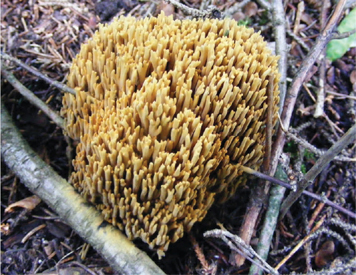
 Ramaria abietina
Ramaria abietina
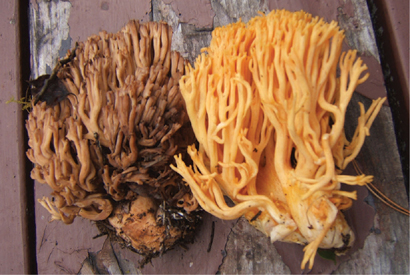
 Ramaria stricta (left) and Ramaria flava (right)
Ramaria stricta (left) and Ramaria flava (right)
Green staining coral mushroom is found under coniferous trees. It is common, sometimes difficult to identify, but has a coconut odor and bitter taste.
R. formosa is poisonous and known to cause severe stomach upset and laxative effect.
Yellow Ramaria has a high food value at four hundred fifty calories per hundred grams (Colak et al. 2009).
 R. botrytis: ergosterol peroxide, cerevisterol, 9alpha-hydroxycerevisterol, (2S,2’ R,3R,4E, 8E)-N-2’-hydrooxyoctadecanol-2-amino-9-methyl-4,8-heptadecadiene-1,3-diol, and 5a,6a-epoxy-3beta-hydroxy-(22E)- ergosta8(14),22-dien-7-one.
R. botrytis: ergosterol peroxide, cerevisterol, 9alpha-hydroxycerevisterol, (2S,2’ R,3R,4E, 8E)-N-2’-hydrooxyoctadecanol-2-amino-9-methyl-4,8-heptadecadiene-1,3-diol, and 5a,6a-epoxy-3beta-hydroxy-(22E)- ergosta8(14),22-dien-7-one.
Other Ramaria species, including R. flava, R. apiculata, and R. formosa show similar cancer-inhibition rates. The inhibition rate against sarcoma 180 and Ehrlich carcinoma is from 60 to 70 percent (Ohtsuka et al. 1973).
The fruiting body contains nicotianamine, an amino acid that inhibits angiotensin 1-converting enzyme, and may be useful in cardiovascular disease (Izawa et al. 2006).
Methanol extracts have been found to be hepato-protective via cytochrome P-450 and antioxidant activity (Kim, H.-J. and K.-R. Lee 2003).
Yellow Ramaria (R. flava) was a name traditionally given to any yellow species, but is now considered inadequate. One study found R. flava to possess antioxidant properties similar to synthetic BHA, and antimicrobial against several Micrococcus species and Yersinia enterocolitica.
Pleurotus applicatus
(BLACK JELLY OYSTER)
Resupinatus is Latin meaning “bent backwards,” while applicatus means “fixed against something.”
Black jelly oyster is a small, black, rubbery bracket fungus that looks like an upside down cup on the underside of logs.
 The mushroom genus contains a number of bioactive sesquiterpenes including 1 (10), 4-germacradiene-2,6,12-triol, and 1,6-farnesadiene-3,10,11-triol, a nerolidol derivative.
The mushroom genus contains a number of bioactive sesquiterpenes including 1 (10), 4-germacradiene-2,6,12-triol, and 1,6-farnesadiene-3,10,11-triol, a nerolidol derivative.
These are the first natural compounds discovered that inhibit cAMP induced appressorium formation in Magnaporthe grisea and show cytotoxic activity.
(FALSE TRUFFLE)
These small, potato-like fungi are found in sandy soil under douglas fir and pine in late summer and fall.
In China, spores of the related R. piceus are used to stop bleeding by sprinkling the powder directly onto wounds.
Recent research has derived the semi-synthetic drug 9 beta-hydroxy anhydro dihydro-artemisinin from this mushroom. This compound is used for anti-malarial activity.
Rhizopogon roseolus, which turns pink with age, has been found as ethanol extract to exhibit activity against Saccharomyces cerevisiae. Methanol extracts showed activity against E. coli, Bacillus subtilis, and Enterobacter aerogenes.
Yamac and Bilgili (2006) found no activity against S. cerevisiae, but results showed activity against Pseudomonas aeruginosa, Staphylococcus aureus, and E. coli from fruiting body extracts.
The mycelium water extracts showed activity against E. coli and S. aureus.
Rhizopogon vinicolor has been found to degrade 2,4-D when supplemented with one mM nitrogen concentration (Donnelly, P. K. et al. 1993).
Experiments with the fungi show some interesting capabilities with regards to the degradation and breakdown of herbicides like atrazine and 2,4D. Is this another possible mycoremediator for northern climates?
Omphalina fibula
Mycena fibula
Gerronema fibula
Hemimycena fibula
Marasmiellus fibula
(ORANGE PIN MUSHROOM)
(PIN MYCENA)
Rickenella is named for the French mycologist A. Ricken. Fibula means “hairpin.”
This small orange fungus grows in mossy areas across northern Canada. It contains minute amounts of psilocybin.
(BEARDED SEAMINE)
This small white fungi appears throughout North America in the fall. Edibility is unknown.
 Mycelial culture: illudane riparols A and B and proto-illudane riparol C; psathyrellon A; 5-desoxyilludosin; and 5-demethyllovalicin.
Mycelial culture: illudane riparols A and B and proto-illudane riparol C; psathyrellon A; 5-desoxyilludosin; and 5-demethyllovalicin.
5-demethyllovalicin is a sesquiterpene that inhibits the human methionine amino peptidase-2 and growth of human endothelial cells (Son 2002).
Psathyrellon A (illudane C) is found, as well, in Psathyrella pseudogracilis and Clitocybe illudens (Omphalotus olearius).
Riparol C possesses weak antifungal and antibacterial properties. Riparol A inhibits the growth of MCF and MDA-MB-231 human breast cancer carcinoma at only one microgram per milliliter (Schüffler 2009).
R. caperatus
Cortinarius caperatus
(THE GYPSY)
Rozites is named after the nineteenth-century French mycologist Ernest Roze. Caperata means “wrinkled.” The mushroom has been re-classified to the Cort genus, but placed here as most people still know it as Rozites.
The gypsy is widespread and common throughout the forests of North America, found singly or in groups on the ground. It is one of my favorite edibles, with a pleasant odor and minty flavor.
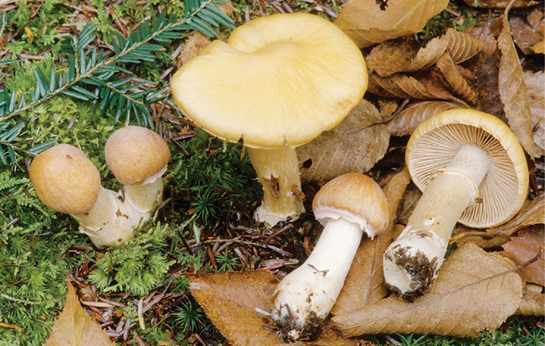
 Rozites caperata (photo credits 1.142)
Rozites caperata (photo credits 1.142)
 S-2-amino ethyl-4-cysteine.
S-2-amino ethyl-4-cysteine.
A new antiviral, RC-183, has been found to show in vitro activity against herpes simplex I and II, as well as varicella-zoster virus, influenza A virus, and respiratory syncytial virus (Piraino and Brandt 1999).
RC28, an antiviral drug based on a protein molecular weight of twenty-eight kD has been shown to be active against a number of enveloped viruses. Activity against cytomegalovirus has been noted.
It is not active against non-enveloped viruses such as coxsackie and strains of ECHO viruses (Piraino 2005). Work is ongoing.
The fungi contain anti-carcinogenic substances, with inhibition rates against both sarcoma 180 and Ehrlich carcinoma of 70 percent (Ohtsuka et al. 1973).
The related R. gonglylophora is cultivated in Brazil by leaf-cutting ants that eat the mycelial hyphae.

 Rozites caperata
Rozites caperata
Russula alutacea
(LEATHERY LOOKING RUSSULA)
R. decolorans
(GRAYING RUSSULA)
R. densifolia
(REDDENING RUSSULA)
R. emetica
(THE SICKENER)
R. laurocerasi
(ALMOND RUSSULA)
R. brevipes
(SHORT STALKED RUSSULA)
R. nigricans R. elephantina
(BLACKENING RUSSULA)
R. xerampelina
(FISHY SMELLING RUSSULA)
(SHRIMP RUSSULA)
R. virescens
(QUILTED GREEN RUSSULA)
(GREEN CRACKING RUSSULA)
R. claroflava
(CHROME YELLOW RUSSULA) (YELLOW SWAMP RUSSULA)
R. cyanoxantha
(VARIEGATED RUSSULA) (THE CHARCOAL BURNER)
R. paludosa
(BOG RUSSULA)
(RED TINTED RUSSULA)
R. subnigricans
(RANK RUSSULA)
R. aeruginea
(QUILTED GREEN RUSSULA)
Russula is from the Russian meaning “red,” as many members of this genus have red caps.
Alutacea is Latin for “resembling thin leather.” Xerampelina is Latin “resembling dried grapevine leaves.” Emetica means “to cause vomiting.” Laurocerasi is Latin for “the odor of bitter almonds.” Flava means “yellow” and virescens is “greenish.” Paludosa means “of the bog or swamp.”
Rank Russula (R. subnigricans), at least the Japanese version, has led to seven deaths in that country. The toxic compound cycloprop-2-ene carboxylic acid has recently been found for the first time in nature (Matsuura et al. 2009).
Graying Russula is edible and so named for the change of color after exposure to air. This mushroom contains various proteinase compounds that have pronounced milk-clotting activity.
Reddening Russula is found in groups under jack pine. It has a sharp taste and is not recommended as an edible.
The sickener (R. emetica) smells fruity, and is usually associated with pine forests. In parts of Slovakia and Hungary, the skin is separated and used to flavor goulash. The rest of the mushroom is discarded. Good idea!
Short stalked Russula is closely related to R. delica, originally described in Europe and rare in North America. It is pickled or marinated in Russia, but never eaten raw.
Blackening Russula, found regularly in the boreal and mixed forests of the west, is inedible.
Quilted green Russula has been found in Montana, and in Alberta at the 2006 NAMA foray in Hinton. It is choice and edible, despite its unusual green color. Many experts consider it the best-flavored Russula, despite small amounts of hydrazine derivatives that dissipate with cooking.
Variegated Russula, known as the charcoal burner due to its large dark green, gray and violet patches that resemble flames, has a faintly nutty flavor and odor. It is edible and best eaten when young.
Bog Russula (R. paludosa) is a rosehip-colored species that fruits early and has an unpleasant fresh odor. It grows in moss and is a choice edible when cooked.
In northern Europe, several of the Russulas are eaten after parboiling and careful preparation. The toxic chemicals are heat sensitive, but not all species are recommended or choice edibles.
In 1986, Jeff Donaghue wrote in Toadstool Review:
Some books have said that any Russula which does not taste acrid is edible. Others will say that even acrid species are OK after being parboiled. While these last two statements may sound a bit careless, there is no Russula known that can even come close to killing you. The worst that can happen is that you may be sick to your stomach or have a bit of looseness in the lower digestive tract. But hey, good chili does that!
When the sea had dried so that men appeared, the first two beings, after planting trees and creating food plants, made two mushrooms. The first man threw one of the mushrooms high into the sky, creating the moon, while the first woman tossed the other mushroom upward and formed the sun.
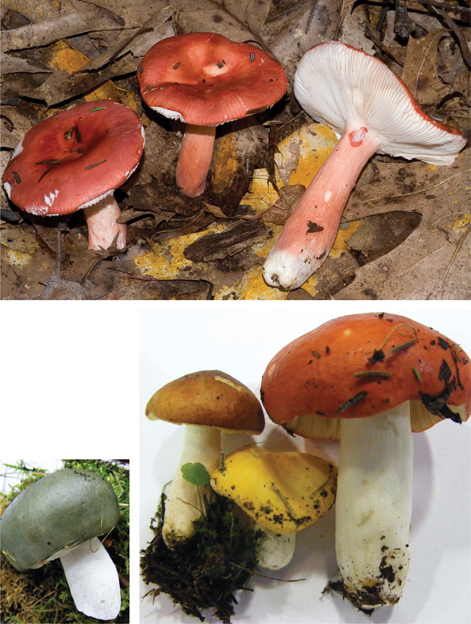
Clockwise from above:
Russula peckii; various Russula species; Russula aeruginea. (photo credits 1.144)

In the Waghi highlands of Papua, New Guinea lives the Kuma tribe, isolated from the rest of the world until the 1930s.
The Kuma have a “mushroom madness” cult that involves the consumption of various species of Russula and Boletus. The mushrooms are boiled in pots and consumed by the whole community, but only a few individuals appear affected by a “shivering madness” called komugl tai. Komugl roughly translates as “deafness (to reason)” and tai to “the shivering bird of paradise.”
A pageant called kai tamb is performed prior to ingestion, with the men dressing up in headdresses decorated with yellow bird of paradise feathers. On the second day of the mushroom brew, the women dance the ndadl, during which they feel free to vent frustrations with their husbands and boast of their sexual exploits. In a sense, it is a ceremonial opportunity to discuss pent up feelings and
issues in a socially acceptable manner. An article by Marie Reay (1977), “Ritual Madness Observed: A Discarded Pattern of Fate in Papua New Guinea,” reveals more.
Leathery looking Russula and reddening Russula are used in traditional Chinese medicine as a component of Tendon Easing Powder, for curing lumbago, painful and numb limbs, and discomfort in bones. The related R. integra, also known as R. polychroma, is also used in Tendon Easing Powder.
The fungus is used effectively for the treatment of dysentery in China.
In China, where it is classified sweet and slightly sour, the dried fungus is used to cure ophthalmocopia, or eyestrain, remove fire from the liver meridian, dissipate heat, and ease constriction of vital energy. It is often given to women suffering poor energy circulation, and is recommended to be taken with ginger in decoction.
The fruiting body of R. vinosa, also known as R. obscura and R. decolorans var. obscura, is cooked in Asia to cure postpartum anemia.
Short stalked Russula possesses strong antioxidant activity and antimicrobial activity against a variety of gram-positive bacteria including Salmonella and Yersinia species, Klebsiella pneumoniae, and Staphylococcus aureus.
The four fungi mentioned above all possess inhibition rates against sarcoma 180 ranging from 60 to 100 percent, and Ehrlich carcinoma from 60 to 90 percent (Ohtsuka et al. 1973).
Almond Russula inhibits the cancer cell lines 90 percent and 80 percent respectively (Ohtsuka et al. 1973).
Various Russula contain russuphelins that have shown activity against leukemia P388 cells lines (Takahashi 1993).
Blackening Russula contains more than eighty percent ergosterols.
Research found R. nigricans to possess strong anti-mutagenic activity.
Inhibition of sarcoma 180 and Ehrlich carcinoma is 60 percent (Ohtsuka et al. 1973).
Work by Mao Xiaolan (1998) suggests the fruiting bodies possess antitumor activity.
Nigricanin is the first ellagic acid from higher fungi, and was isolated from the fruiting body by Tan et al. (2004). Ellagic acid is found in strawberries, raspberries, and various nuts, and possesses both antioxidant and antitumor properties.
A dichloromethane extract has been found active against Biomphalaria glabrata (Keller, C. et al. 2002).
One rat study of quilted green Russula suggests it may be helpful in blood cholesterol reduction. The same study showed reduced liver enzyme markers related to liver and oxidative stress, as well as increased levels of SOD.
Galactomannan content is believed responsible for free radical scavenging (Sun, Y. et al. 2010a).
Studies in laboratories show an inhibition rate of 70 percent for both sarcoma 180 and Ehrlich carcinoma (Ohtsuka et al. 1973).
Chrome yellow Russula is a bright yellow, edible species with a pleasant vanilla or coumarin-like odor. Studies have found gold levels of 136 nanograms per gram in the fruiting body. Organic gold has a number of medicinal properties, including the treatment of various forms of depression and rheumatoid arthritis.
The similar looking R. ochroleuca contains termitomycesphin E. As the name suggests, these compounds are commonly found in Termitomyces species associated with termite nests. A Chinese edible, T. albuminosus, contains various termitomycesphins that induce neuronal differentiation in rat PC12 cells.
Variegated Russula contains a ceramide with an unusual sphingoid base and could hold the basis of a new medicine, as sphingolipids help anchor lipid-bound carbohydrates to cell surfaces and create an epidermal water permeability barrier; participating in both antigen-antibody reactions and biological information transmission (Kolter and Sandhoff 1999; Gao, J. M. et al. 2001). Early work found this mushroom inhibited growth of sarcoma 180 and Ehrlich carcinoma cell lines by 70 percent and 60 percent respectively.
Lepidamine, isolated from the related R. lepida, is the first aristolane-type sesquiterpene alkaloid isolated from nature. Lepidolide has also been identified (Tan et al. 2002, 2003).
A novel lectin in this species exhibits activity against Hep G2 and MCF-7 breast cancer cell lines.
Inhibition rate of cultured mycelia against sarcoma 180 is 100 percent.
The related R. adusta shows 80 percent inhibition of both sarcoma 180 and Ehrlich carcinoma cell lines, and the related R. crustosa 70 percent inhibition. Russula lilacea inhibits the cell lines 60 to 70 percent, comb Russula (R. soraria) by 60 percent, and R. sanguinea (R. rosacea) and R. vesca up to 90 percent.
Blushing red Russula (R. rubescens) shows inhibition of 70 percent and 60 percent respectively, while R. sanguinea, another red Russula, shows 90 percent inhibition against both cancer cell lines.
The related European species R. foetens has been found to inhibit sarcoma 180 and Ehrlich carcinoma cancer cell lines by 70 percent. Likewise for R. aurea.
Work by H. Wang and T. B. Ng (2007) found extracts from R. paludosa inhibit HIV-1 reverse transcriptase by 97.6 percent. One fraction, SU2, showed an IC50 of eleven micromoles, suggesting further investigation in regards to a natural product for AIDS.
Shrimp Russula (R. xerampelina) demonstrated activity against malaria-inducing Plasmodium falciparum (Lovy et al. 1999).
Russula emetica (Agaric emetic) is used for severe vertigo, indicated in part by a longing for cold water, which relieves symptoms. There may be gastritis, with an ice-cold sweat, vertigo, weakness, sneezing, vomiting, and a sensation as if the stomach was suspended on a string. Sensations of deadly nausea and dislike of wine and meat are noted.
Dose: low potency as needed (Boericke).
(SCALY HEDGEHOG)
S. aspratus
(KOOTAKE)
Sarcodon is Greek meaning “fleshy tooth” and imbricatus is Latin meaning “covered with scales.”
Scaly hedgehog is found throughout the Pacific Northwest and north to the Yukon and Alaska amongst coniferous forests. It is a very popular edible with mycophiles from eastern Europe.
The young specimens can be eaten after cooking, and the older, slightly bitter caps are better when boiled first and then fried. I find them an excellent edible.
This mushroom contains nearly 26 percent protein, with seven essential amino acids making up nearly 43 percent of the total. It is high in potassium, calcium, and magnesium.
The sphorophore of scaly hedgehog lowers blood cholesterol levels in lab animals.
The fruiting body shows antibacterial activity against E. coli, Enterobacter aerogenes, Salmonella typhimurium, Staphylococcus aureus, S. epidermis, and Bacillus subtilis (Yamac and Bilgili 2006).
Four different solvent extracts have been found to be active against B. subtilis.
The related S. aspratus has been studied and found active in reducing inflammation, lesions, and plaque associated with cardiovascular risk (Ryong et al. 1989).
Takei et al. (2005) found acetone extracts markedly inhibited the growth of HL-60 human leukemia cells and induced apoptosis after twenty-four hours of incubation. The main active component was identified as ergosterol peroxide, with complete inhibition at twenty-five micrometers.
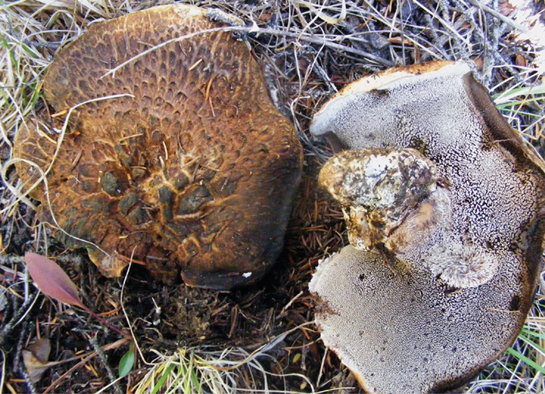
A fucogalactan, isolated from the fungus, elicited the release of TNF-alpha and NO in macrophages. The TNF-alpha production with one-tenth the amount of lentinan was approximately 4.3-fold. The author suggests that the immune modulating effect may contribute to antitumor activity in tumor-bearing hosts as well as various immunomodulating effects.
One study identified a sterol, 9(11)-DHEP, that is a very effective inhibitor of HL-60 cell growth and strong apoptosis. It also inhibits HT29 colon and adenocarcinoma cells but not normal cells by inducing CDKN1A expression.
A water-soluble polysaccharide stimulates cultured mice spleen lymphocytes, suggesting immune enhancement.
The related S. cyrneus contains cyrneines A and B, both of which significantly promote neurite outgrowth. Neither showed cytotoxity at one hundred micromoles. The same author identified cyrneine C and D, as well as claucopine C.
Activity on neuritis suggests nerve growth factors at play.
Plectania coccinea
(SCARLET CUP FUNGUS)
This cup fungus, more common in cold weather, has a bright red surface on fertile interior, with a whitish exterior. It is associated with willow, alder, and poplar forests.
The coloration is due to carotenoids such as beta-carotene and plectaniaxanthin. The mushroom does contain lectin-binding lactose, N-acetylatosamine, N-nitrophenyl-beta-D-gluco, and galacto-pyranosides.
(SPLITGILL)
Split gill (Schizophyllum commune) is a fan-shaped, grayish-white, and unusual fungi found on living and decaying poplar, sometimes on birch, and occasionally on spruce and pine.
It has unique, lengthwise, split gills that fold back in dry weather, with no stalk to speak of. The fungus is very common, and found worldwide, as the species name infers.
It is used in Mexican cooking, with sesame seed and beans.
In Zaire, it is first boiled for several hours with vegetable salt to tenderize, and then served with peanuts, salt, and oil for seasoning. It is also consumed throughout India and Southeast Asia.
It is probably prudent to avoid eating raw. People who have done so have been found to have abnormal growths in the mouth and throat that, upon isolation, were shown to be schizophyllum.
In traditional Chinese medicine, the fungus is considered to have a sweet taste and be very mild in nature. It is recommended for general weakness and debility.
In China, it is sometimes cooked with eggs to make a preparation for leucorrhea.
In Mexico, it is considered by natural healers to have a cold energetic quality, reducing fevers and inflammation.
 Cysteine and glutamine, 17 percent protein, schizophyllan or sizofiran (SPG) (1-3-alpha-D-glucarin- polysaccharide), cholesterol oxidase, schizostatin, a novel phenylalanine specific amino peptidase, a branded D-glucotetraose, multiple proteases, invertase and ferulic acid esterase activity, acid phosphatase isozymes, schizoflavins, various cerebrosides, glucoceramide, and two amino-isobutyric acids.
Cysteine and glutamine, 17 percent protein, schizophyllan or sizofiran (SPG) (1-3-alpha-D-glucarin- polysaccharide), cholesterol oxidase, schizostatin, a novel phenylalanine specific amino peptidase, a branded D-glucotetraose, multiple proteases, invertase and ferulic acid esterase activity, acid phosphatase isozymes, schizoflavins, various cerebrosides, glucoceramide, and two amino-isobutyric acids.
 The dried fungus contains, per one hundred grams, 280 milligrams iron, 646 milligrams phosphorus, and ninety milligrams calcium.
The dried fungus contains, per one hundred grams, 280 milligrams iron, 646 milligrams phosphorus, and ninety milligrams calcium.
Schizophyllum shows antitumor activity against both the solid and ascites forms of sarcoma 180, Ehrlich carcinoma, as well as Yoshida and sarcoma 37 and lung carcinoma (Komatsu et al. 1969; Yamamoto, T. et al. 1981).
In Lithuania, the mushroom is noted for its antitumor activity. One German study found it decreased sarcoma 180 tumors by 99 percent at the rate of only one milligram per kilogram (2.2 pounds) of body weight.
It has been shown to increase immunity by restoring suppressed killer-cell activity to normal levels in mice with tumors.
The fungus is anti-infective against Pseudomonas aeruginosa, Staphylococcus aureus, E. coli, and Klebsiella pneumoniae.
Schizophyllum is structurally similar to lentinan, an active component of shiitake, but differs in that it does not directly activate T-cell production.
In 1992, Dr. Uchida at Kyoto University announced he had tested the beta-glucans in eleven chronic fatigue syndrome patients, with ten showing improvement. Of these, three were able to return to work, and the other seven, some so ill they could not walk a flight of stairs, resumed “a regular life.” For all ten patients, their NK-cell activity levels were restored to normal.
By the summer of 1993, thirty more patients, including some Americans and Canadians, were treated with twenty milligrams per day of SPG. After one to two months, more than 90 percent found their debilitating fatigue reduced or gone entirely, without any side effects.
Serum levels of interleukin 2, which previously were elevated, returned to normal. Elevated levels would tend to indicate immune activity, since these receptors are found on the membrane of T-cells in an activated state. However, the responsiveness of T-cells to activations by interleukin-2 only returned to CFS patients after SPG therapy. It is worth noting that patients with major depression also show higher than normal levels of interleukin-2.
In a normal, healthy person, interleukin-2 causes NK-cells to become active. But Dr. Uchida (1995) found that interleukin-2 receptors on the NK-cells of CFS patients were normal, and yet the NK-cells would not respond to the interleukin 2 signals to become active. After administering SPG, they did. This is exciting news for long time sufferers of chronic fatigue syndrome and related autoimmune conditions of unknown origin. A patent was issued in the same year for proprietary preparation.
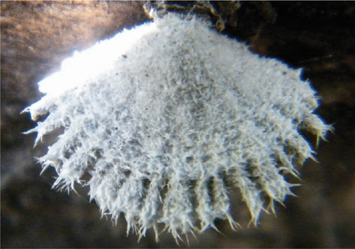
 Schizophyllum commune (from below)
Schizophyllum commune (from below)
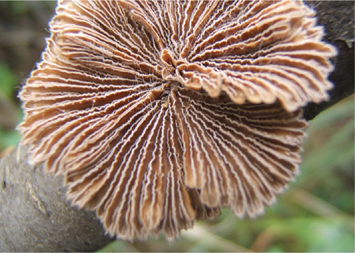
 Schizophyllum commune (from above)
Schizophyllum commune (from above)
Beta-D-glucans bind to membrane complement receptor type 3 on immune effector cells. The ligand receptor complex can be internalized, and the intracellular events that occur have been poorly understood to this point. Schizophyllan has been shown able to bind the mRNA poly(A) tail. The molecular weight, branching pattern, and presence of single and triple helices all significantly alter the activity of beta-glucans. In general, and with some exceptions such as the MD fraction of Grifola frondosa, higher antitumor activity is associated with higher molecular weight, lower levels of branching, and greater water solubility.
The greatest improvements with SPG were reduction of swollen lymph nodes, sore muscles, neuropsychological problems and pharyngitis.
It is distributed in the body in macrophages, tissues next to tumors, and in the bone marrow, lymph nodes, liver, and spleen.
In the bone marrow cells of mice, it has been shown to inhibit chromosomal damage caused by chemotherapy drugs and radiation.
The best results were obtained when administered shortly after radiation, and restored mitosis of bone marrow cells previously suppressed by drugs.
Human studies with recurrent and inoperable gastric cancer on 367 patients showed significantly longer life span when schizophyllan was combined with chemotherapy.
In combination with radiation, it significantly prolonged the five-year survival rate of stage II cervical cancer patients, but not stage III patients. However, those given the fungi extract showed more “significantly rapid” restoration of T-lymphocyte levels following radiation than controls.
Schizophyllan when injected intra-tumor to cervical cancer showed significant infiltration of Langerhans’ cells, as well as T-cells (Nakano et al. 1996).
Schizophyllan increases interferon-g production, making it beneficial to hepatitis B patients. This is due to enhanced response to the virus through production of interferon-g.
Yo Kimura et al. (1994) showed schizophyllan an assistant to immuno-therapy in the treatment of neck and head cancers, increasing survival rates of patients receiving the compound.
Enhancement of Th1 immune response from mycelium has been shown.
C. H. Han et al. (2005) identified a novel homodimeric lactose binding lectin with potent mitogenic activity, anti-proliferation to tumor cell lines, and inhibition of HIV-1 reverse transcriptase. This was from the fresh fruiting body of split gill, with stability up to forty degrees Celsius (104 degrees Fahrenheit).
Schizostatin, another derivative, is a potent squalene synthase inhibitor.
D-glucotetraose is an interesting component as it is part of the repeating unit of extracellular polysaccharides found in maitake, a very well researched fungi with antitumor activity.
In Japan, cultured broth products are produced, called Sizofiran, Sonifilan, SPG, or Schizophyllan. Produced by Kaken Pharmaceutical of Tokyo, SPG is now mainly used in the treatment of cervical cancer.
One study identified a lectin that exhibits potent mitogenic activity toward splenocytes and anti-proliferation against tumor lines, and inhibits HIV reverse transcriptase (Han, C. H. et al. 2005).
Schizophyllan (1-3-alpha-D-gluco-pyranan) is found in razor strop (Piptoporus betulinus), a much larger and more common bracket fungus in northern boreal forests.
A U.S. patent (5320849) involves liquid cultivation for isolated branched glucans with applications for skin aging, whitening, and repairing skin damage.
This mushroom has been well researched by the pulp and paper industry for de-colorization of mill effluent.
It removed nearly 80 percent of the color in five days in one study. Other work, by Belsare and Prasad (1988), also found efficacy in decolorization of effluent from pulp.
It has application in L-malic acid fermentation production.
Growing the mushroom under controlled conditions is best achieved at twenty-five degrees Celsius (seventy-seven degrees Fahrenheit) and 5.5 pH, with a mannitol or sorbitol substrate and sufficient B2 and B6.
Nine to sixteen grams as a decoction up to three times per day. Prepare at a 1:5 ratio.
It is a very hardy fungus. Dr. Buller, a famous Canadian mycologist, showed that specimens enclosed in glass tubes for thirty-five years were still able to sporulate!
Like most fungi, S. commune fungal filaments pair with another. These must be of differing “mating types,” and in this particular mushroom some twenty-eight thousand kinds of pairings are possible, since unlike humans, there are more than two genders.
Cerebroside A on rice leaves induced the accumulation of antimicrobial compounds (phytoalexin), cell death, and increased resistance to subsequent infection by compatible pathogens.
S. polyrhizon
(DEAD MAN’S HAND)
(EARTHSTAR SCLERODERMA)
S. verrucosum
(EARTHBALL)
(WARTED DEVIL’S SNUFFBOX)
(ROOTING TOUGHSKIN)
(SMOOTH EARTHBALL)
S. citrinum
S. aurantium
Lycoperdon aurantium
(PIGSKIN POISON PUFFBALL)
(COMMON EARTHBALL)
Scleroderma is Greek meaning “tough skin.” Citrinum means “lemon yellow” and verrucosum means “full of small warts.”
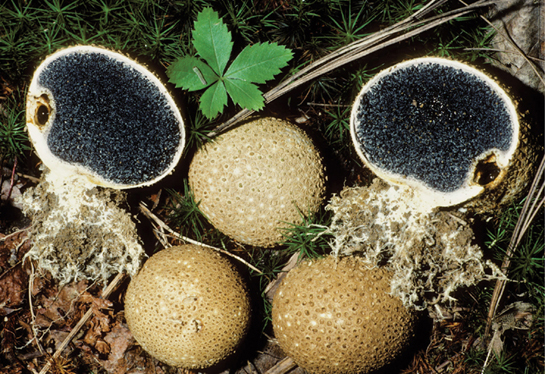
 Scleroderma citrinum (photo credits 1.149)
Scleroderma citrinum (photo credits 1.149)
Dead man’s hand resembles a hard puffball. It matures and splits open like a Geastrum and takes on the look of the outstretched palm of a buried corpse.
They can be mistaken, initially, for puffballs but have a hard, thick skin with a purplish to black interior. This species is poisonous, not edible. Another difference is that puffballs are saprophytic, while this one is mycorrhizal.
Some Scleroderma species, such as S. citrinum or pigskin poison puffball, are considered poisonous, and yet they have been used in several cultures to cause narcosis and visual disturbance.
It is sometimes canned in central Europe and sold as a substitute for truffle. It is way too pungent to be used as a condiment. Although not recommended, the dose is one half of an unripe fruiting body. It has a distinct rubbery smell.
In Germany, it is known as kartoffel bovist, or “potato bovist.”
According to Adrian Morgan, his personal experience ingesting one half a small specimen resulted in a deep sleep of two hours, followed by a period of restlessness and pupil dilation. The chemical structure has not been identified.
The related S. verrucosum is believed to contain psychoactive compounds, as well.
In China, the mushroom is used to counteract swelling, stop bleeding, and cure hemorrhage from external cuts or wounds. It is used for watery chilblains, with an appropriate amount of powdered spores applied to the wound.
 Scleroderma citrinum: contains norbadine A, sclerocitrin, badione A, xerocomic, methyl 4,4’-dimethoxyvulpinate, 4,4’dimethoxyvulpinic acid, and a lanostane-type triterpenoid. Sclerocitrin, which provides the distinct yellow color, is found up to four hundred milligrams per kilogram. It is also present in Chalciporus piperatus.
Scleroderma citrinum: contains norbadine A, sclerocitrin, badione A, xerocomic, methyl 4,4’-dimethoxyvulpinate, 4,4’dimethoxyvulpinic acid, and a lanostane-type triterpenoid. Sclerocitrin, which provides the distinct yellow color, is found up to four hundred milligrams per kilogram. It is also present in Chalciporus piperatus.
The lanostane-type triterpenoid exhibits significant antiviral activity against herpes simplex, while vulpinic acid derivatives exhibit activity against Mycobacterium tuberculosis, as well as cytotoxicity against the NCI-h187 cell line.
Earthball (S. citrinum) essence is for those who think they are not good enough, lack self-worth, or boundaries. It helps to sustain grounding when life becomes difficult when working through transformation.
—BYRNAHERB
Earthball essence is for difficult life situations, for crises and helping one maintain and review so that one does not fear it and has possible solutions.
—MARIANA
Frans Vermeulen speculates that “on the basis of analogy/signature Scleroderma might be considered for scleroderma (thickening of the skin caused by swelling and thickening of fibrous tissue) and cellulite. The Dutch name for the latter condition, sinaasappelhuid (‘orange peel skin’), wonderfully matches the specific name aurantia, orange peel.”
Millet hosts a pathogenic fungus that infects both the leaf blades and flowers. The chlorophyll of infected blades disappears and the blades break up into spreading, thin-stranded filaments called “white hair disease.”
The flowers also change into long-leafed floral buds that are hairy.
The diseased spikes are collected in the fall and dried in the sun.
In traditional Chinese medicine, the diseased spikes are prized for their diuretic and antipyretic properties.
For debility and edema, agitation, thirst and lack of urine flow, it will increase diuresis.
Chloroform extracts of Ganoderma applanatum have been found to inhibit growth of this pathogen in greenhouses.
For urethritis and prickly pain during urination, decoct six to fifteen grams chaff of infected grain with water and drink at body temperature two times per day.
These small cup-shaped fungi are often found in vegetable gardens, where they injure members of the legume, cabbage, or nightshade families.
They produce spores from a hard black fungus or sclerotium in a manner similar to tuckahoe.
In Japan, researchers have been fermenting and culturing S. sclerotiorum for many years and have isolated a dextran or polysaccharide that inhibits the growth of sarcoma 180.
They contain sclerin and sclerolide, which are co-metabolites of sclerotinin A and B, related to citrinin, and other isocoumarins. These are plant growth promoters. Sclerothionine is a sulphur containing imidazole isolated from S. libertiana cultured on bran.
Studies indicate Sclerotinia species may possess tumor inhibition.
Gyrophana lacrymans
Merulius lacrymans
(DRY ROT FUNGUS)
This is a serious, destructive fungus in older wooden houses, often developing in poorly ventilated areas under floorboards. Dry rot is so named because it extracts moisture from the wood and cracks it into small cubes that eventually crumble into a fine, dark dust.
Studies have shown the fungus to inhibit the growth of sarcoma 180 by 70 percent and that of Ehrlich carcinoma by 60 percent.
Early work by Hervey (1947) found significant activity against Staphylococcus aureus.
A culture of the related S. himantiodes, often found on dead conifers, produced antibiotic metabolites as well as himanimide C, which exhibits antifungal activity against Alternaria porri, Aspergillus ochraceus, and Pythium irregulare. It is cytotoxic to HL-60 and L1210 human cancer cell lines.
The vaguely related wet rot (Coniophora puteana) shows moderate activity against S. aureus. Robbins et al. (1945) found the related C. cerebella and C. suffocata active against both S. aureus and E. coli.
Gas chromatography of S. lacrymans essential oil reveals nineteen constituents, including 1-octen-3-ol and 2-methylbutanal.
Research has found activity against various chemical toxins, including chromated copper arsenate and polycyclic aromatic hydrocarbons. It shows tolerance to copper citrate.
Culture growth is greatly increased by exposure to infrared rays.
S. radicata
S. ramosa
S. spathulata
Manina crispa
Masseola crispa
(SPONGE FUNGUS)
(CAULIFLOWER FUNGUS)
Sparassis is from the Greek meaning “torn apart,” while crispa means “curly.” The French call it fall morel.
This unusual fungus grows at the foot of coniferous trees, looking just like a wild cauliflower, hence the common name. They can be quite large, up to nearly a meter across and weighing more than thirty kilograms (sixty-six pounds). You will most frequently find them on the east side of pine or spruce facing east and protected from the prevailing winds.
It is a prized edible, with a very fragrant tealike scent; but it must be cooked for a long time unless you enjoy chewy food. The initial scent of latex and ammonia changes with cooking, resulting in a good textured addition to dishes.
For best results cook for at least one hour in chicken broth and then remove and slice thinly. Individual leaflets can be battered with tempura and deep-fried. I prefer the chewy texture in stir-fry.
The western species is considered to be S. radicata and the eastern species, S. spathulata. S. crispa is found in Europe and parts of eastern North America. All are delicious.
 Sarassol, 348 micrograms benzoic acid per gram, eighteen micrograms caffeic acid per gram, thirty-six micrograms narigenin per gram, twenty-four micrograms quercitin per gram, and thirty-eight grams p-coumaric acid per gram, as well as xanthoangelol and 4-hydroxyderricin.
Sarassol, 348 micrograms benzoic acid per gram, eighteen micrograms caffeic acid per gram, thirty-six micrograms narigenin per gram, twenty-four micrograms quercitin per gram, and thirty-eight grams p-coumaric acid per gram, as well as xanthoangelol and 4-hydroxyderricin.
Antifungal metabolites have been identified.
One constituent, sparassol, possesses anti-fungal and antibiotic activity. Unknown, and unnamed constituents inhibit various Bacillus species.
Sparassol was isolated and named by Falck in 1923 and is one of the earliest crystalline antibiotics to be examined.
Work by St. Pfau, Spath, and Jeschki in 1924 found the substance identical to the methyl ester of everninic acid, obtained from the lichen Evernia prunastri, isolated in 1848 by Stenhouse.
C. Keller et al. (2002) found dichloromethane extracts active against B. subtilis and E. coli, and molluscicidal on Biomphalaria glabrata. Early work by Hervey (1947) and Robbins et al. (1945) showed activity against E. coli and S. aureus.
A novel bioactive compound and another also present in Antrodia camphorata inhibits melanin synthesis by melanoma cancer cells and inhibit the growth of MRSA, or methicillin-resistant Staphylococcus aureus (Kawagishi et al. 2007)
Research by Ohno et al. (2002) looked at this edible and medicinal mushroom that is cultivated in Japan, and known as hanabiratake.

 Clockwise from above:
Clockwise from above:
Sparassis crispa;
Sparassis spathulata;
Sparassis radicata. (photo credits 1.150)
It contains over 40 percent of six-branched 1,3-beta-glucans, which show antitumor activity. The beta-glucan fraction can be extracted with cold dilute sodium hydroxide.
One research team identified a polysaccharide with antitumor activity. Both sarcoma 180 and Ehrlich carcinoma were 100 percent suppressed during in vitro studies, and the hematopoietic response was enhanced.
Petrova et al. (2007) found a diethyl ether extract inhibits the degradation of IkBalpha, associated with anticancer potential.
K. Yamamoto et al. (2009) found Sparassis helps suppress angiogenesis and metastasis in lung cancer cell lines.
Mouse studies found the extract modulated recovery rates in cyclophosphamide-induced leukopenia. In Peyer’s patches, recovery of the T-cell/B-cell ratio was faster than controls, and in vitro, both interleukin-6 and interferon gamma production are enhanced. This strongly suggests improved hematopoietic response due to enhanced cytokine production (Ohno et al. 2002).
Ohno et al. (2003) looked at the enhanced cytokine capacity of the beta-glucan extract in healthy volunteers. Three hundred milligram capsules were given orally to several cancer patients, with improvement after several months in nine of the fourteen patients, suggesting possible application to human cancer immunotherapy.
Human NK cell cytotoxicity was enhanced without increasing the number of NK-cells, suggesting that oral intake activates Th1 cell, and inhibits Th2 cell activation, promoting a shift toward Th1 dominant immunity.
One study showed activity on human leukocytes, including enhancement of IL-8 synthesis, release of complement fragment C5a, and induction of anti-beta-glucan natural antibody in human plasma.
Harada et al. found six branched 1,3 beta D-glucans induced cytokines by granulocyte macrophage colony stimulating factor (Harada et al. 2004). Earlier work in by the same research team found the glucans enhanced the hematopoietic response in mice treated with cyclophosphamide (Harada et al. 2002a).
Harada et al. (2006b) also found polysaccharide fractions show strong antitumor activity against sarcoma 180 and in cyclophosphamide induced leukopenic mice. Sodium hydroxide treatment of the hot-water extracts decreased the hematopietic response of cytokine induction. Immune-modulating effects of the mushroom are significantly modified by the method of preparation.
The same author found SCG from this mushroom completely abolished cytokine activity in dendritic cells from dectin 1-knockout mice (Harada et al. 2008).
The mushroom appears to relieve rhinitis through induction of IFNgamma but at the same time inhibits IL-4 and IL-5 secretion. Serum IgE levels were also reduced.
Harada et al. (2002b) found polysaccharides induce interferon gamma and interleukin-12 p70 production. They earlier identified tumor necrosis factor alpha and granulocyte-macrophage colony stimulating factor by the beta-glucans.
Further work found the glucans synergistic with soy isoflavones, suggesting a model for hormone sensitive cancer cell lines (Harada et al. 2005).
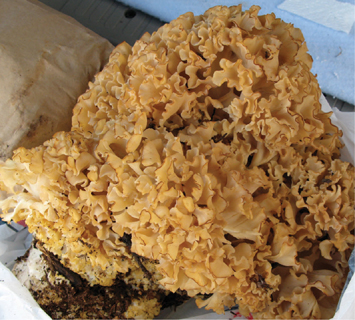
More recent work by Harada et al. (2006a, 2006c) suggests that cell-to-cell contact and soluble factors are important for cytokine induction by the beta-glucans, and specifically that increased levels of GM-CSF and dectin-1 (a beta-glucan receptor) expression are crucial to this induction.
It appears that the mushroom supports innate immunity through activation of macrophages, induction of dectin-1 receptor and inflammatory cytokines, and secretion of inflammatory cytokine influence by TLR4 stimulation (Kim, S. I. et al. 2009).
Petrova et al. (2005) suggest that the mushroom inhibits breast cancer activity.
Compounds other than beta-glucans from hot-water extracts were found to suppress tumor growth, increase IFN-gamma production, and reduce the growth of new blood vessels that accompany tumor growth (angiogenesis). These low molecular weight compounds enhance the Th-1 response, at least in mice studies (Yamamoto, K. et al. 2007).
Three antifungal compounds have been found in submerged culture, including sparassol, ScI, and ScII; the latter two show the greatest activity against Cladosporium cucumerinum.
A hot-water extract of the mushroom inhibits HIV by over 50 percent at a concentration of only one milligram per milliliter (Wang, H. and T. B. Ng 2007).
Kodani et al. (2008) were screening for MRSA (methicillin-resistant S. aureus) activity and found two chalcones previously isolated from Angelica keiskei. This is the first report of chalcones from the fungal kingdom, and may have potential for production of these two compounds, xanthoangelol and 4-hydroxyderricin.
Xanthoangelol has been found to lower blood pressure and reduce lipid metabolism and LDL levels in stroke-prone hypertensive rats.
The mushroom may ameliorate cerebrovascular and othelial dysfunction and may be useful for preventing stroke and hypertension (Yoshotomi 2011).
It induces apoptosis of stomach cancer cells. The compound inhibits gastric H(+)-ATPase.
Xanthoangelol D improves vascular health via NFkappaB activation.
One study found the compound effective for neuroblastoma and leukemia apoptosis via activating capase 3, but not involving Bx/Bcl-2 signal transduction.
It has the same antibiotic effect as gentamicin on Micrococcus luteus (Inamori et al. 2008).
Xanthoangelol is anti-metastatic and antitumor in activity (Kimura, Yoshiyuki and Kimiye Baba 2003).
Oral consumption of the mushroom helped promote healing of impaired diabetic wounds. It appears to directly increase synthesis of type 1 collagen.
The fungus has been found “effective in suppressing blood sugar levels,” according to a recent Japan Scan Food Industry bulletin. No commercial products are presently marketed and available in North America.
Hyuk-Gu Park et al. (2009) found nanoparticle extraction of beta 1>3-D-glucans very efficient with 90 percent water soluble after only ten minutes of incubation.
Their growth can be promoted by inoculating tree stumps with spored dowels or simply burying the stem butts in the ground near a tree base with a fresh root wound. According to Paul Stamets, the long taproot can be replanted and will regrow. He believes it a valuable ally in preventing the spread of honey mushrooms (Armillaria species) by outcompeting for the tree without killing the host.
Stamets plans to inoculate the perimeter of a clear-cut forest populated with Armillaria to research whether fungal barriers can be effective reforestation tools.
The fungus uptakes arsenic in affected zones, suggesting mycoremediation potential.
(HAIRY STEREUM)
(HAIRY PARCHMENT)
S. subtomentosum
S. ostrea
(FALSE TURKEY TAIL)
Hairy parchment (Stereum hirsutum) is a cinnamon-colored bracket fungus found on birch and other deciduous trees. It shelves and overlaps in two-centimeter by two-centimeter strips leathery strips that become gray with age. It often shares logs with witch’s butter (Tremella mesenterica). It has an affinity for felled logs, often found growing on the cut face.
False turkey tail is often mistaken for Trametes versicolor. Some authors consider S. ostrea and S. subtomentosum to be the same mushroom while others disagree. I can’t tell.
Stereum complicatum is found on branches and twigs of hardwood trees in eastern and central North America. They are plentiful and beautiful to the eye.
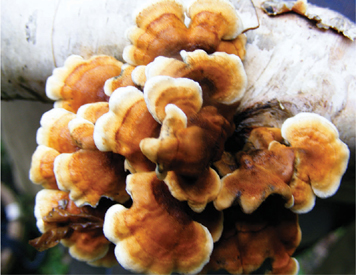
 Stereum hirsutum
Stereum hirsutum
 S. hirsutum: hursutic acids, sterin A and B, ergosta-7,22-dien-3b-ol, mycosporine, sterelactones, stereumin A-E, and epidoxysterols 1–4.
S. hirsutum: hursutic acids, sterin A and B, ergosta-7,22-dien-3b-ol, mycosporine, sterelactones, stereumin A-E, and epidoxysterols 1–4.
 S. vibrans: vibralactone.
S. vibrans: vibralactone.
 S. complicatum: vibralactone.
S. complicatum: vibralactone.
Stereumin A-E are canadine sesquiterpenoids grown in culture broth. The D fraction showed particularly aggressive nematicidal activity against Panagrellus redivivus (Li, P. et al. 2007).
The fungi produce hirsutic acids, among which the A version inhibits the growth of suppurated Micrococcus pyogenes, and the N version inhibits the growth of Diptheria bacilli and Neisseria meningitidis.
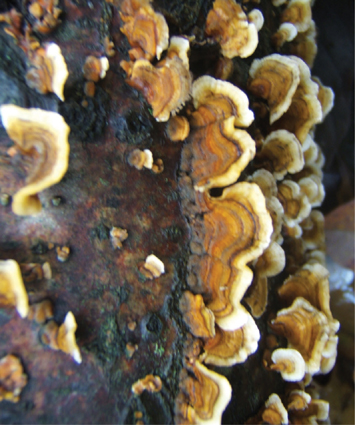
 Stereum hirsutum
Stereum hirsutum
The whole mushroom possesses antibiotic activity. One study showed activity against Bacillus cereus. Another study showed activities against B. subtilis, E. coli, Staphylococcus aureus, and Salmonella typhimurium.
Hirsutic acid A has been found to inhibit S. aureus at a ratio of one in eight thousand.
Sterelactones, new isolactaronetype sesquiterpenoids, show antifungal activity (Opatz et al. 2008).
The mushroom contains ergosta-7,22-dien-3b-ol and hirsutic acid C, an inactive precursor of antibacterial activity with an unknown structure.
The compounds sterin A and B inhibit lipid peroxidation, suggesting antioxidant properties (Yun et al. 2002b).
The same author identified hirutenol F with an EC50 of 0.39 micromoles.
It contains mycosporine, with yet unknown properties. Cultured broths contain tricyclic sesquiterpenes, hirsutenols A-C (Yun et al. 2002a).
Work by Hervey in 1947 suggested moderate activity against S. aureus and E. coli.
Epidoxysterols 1–4 show significant activity against Mycobacterium tuberculosis.
A dry extract inhibits thrombin by 34 percent in a docking manner similar to phosphonate thrombin inhibitors.
The mycelium of the related S. subpileatum, or Lloydella subpileata, has shown antagonism to the growth of sarcoma 180.
The oak-loving S. gausapatum shows inhibition of sarcoma 180 by 90 percent and Ehrlich carcinoma by 100 percent.
The related S. fasciatum (S. ostrea/S. lobatum) contains laricinolic and methoxylaricinolic acid.
Related species, such as S. rugosum, S. sulcatum, S. gausapatum, S. fuscum, and S. fasciatum show moderate to significant activity against S. aureus (Robbins et al. 1945).
The related S. vibrans (Boreosterum vibrans) contains vibralactone, a potent inhibitor of pancreatic lipase.
The bright orange spore-bearing S. complicatum contains a closely related compound, percyquinnin that is also a potent lipase inhibitor. This compound has turned out to be identical to vibralactone.
The inhibitory mechanism of vibralactone may be similar to orlistat, a derivative of the streptomycete compound lipstatin, which is a prescription drug for obesity.
Another relative, S. murrayi, has a vanillalike fragrance, while S. rugosum is fruity and banana-like. The former shows activity against both E. coli and S. aureus.
The closely related Aleurodiscus amorphous shows inhibition against sarcoma 180 and Ehrlich carcinoma of 100 percent.
Two strains of S. hirsutum were investigated in South Africa for use in the pulp and paper industry, and found to produce paper of improved strength.
Stereum hirsutum is a lignin degrading fungi that was used in one experiment to degrade bisphenol A in culture. It showed high resistance to the chemical and in seven to fourteen days completely degraded the toxin. Estrogen activity was tested upon completion and found very effective at clean up (Lee, S.-M. et al. 2005).
The related S. subtomentosum has been found to contain protease, amylase, phytase, carboxyl esterase, and lipase enzyme activity, suggesting a wide application of use in various industries (Goud et al. 2009).
S. strobilaceus
(OLD MAN OF THE WOODS)
If dignity can be attributed to a mushroom, then the old man of the woods would get the “Most Dignified” award.
—WALT STURGEON, NORTH AMERICAN
MYCOLOGICAL ASSOCIATION MEMBER
Darkly knobbed with warts he stands
Close to the ground. His cap, a coffee cup
Drained of its brew; his mouth hangs open loosely …
No armor against foul weather
His suit, threadbare and shaggy
Wears thin. Black knight of fast
Declining years, he has been vulnerable
All his life.
—JESSIE KEIKO SAIKI, WISCONSIN
MYCOLOGICAL SOCIETY NEWSLETTER,
FALL 1983
Strobilomyces is from the Greek meaning “a cone-like fungus.”
Although mainly an eastern species, found under oak, it is occasionally related to conifers. It is a rather distinctive bolete, with a shaggy black or gray fruiting body. The flesh is white, but becomes red and then black after exposure to air. It is edible, but not highly rated.
Ethanol extractions inhibit both Ehrlich ascites tumor and Yoshida sarcoma growth.
(WESTERN CONE MUSHROOM)
S. trullisatus
(DOUGLAS FIR CONE MUSHROOM)
Both cone mushrooms grow on old, and often buried, cones of pine, spruce, and douglas fir.
The former may sometimes be found on the leaf stems of poplar species.
The compounds show antitumor activity in vitro when tested on Ehrlich carcinoma cell lines. They can also shut down respiration.
The related S. tenacellus contains strobilurins. One active metabolite, strobilurin A, identical to mucidin, has been used as a blueprint for synthetic strobilurins, a broad-spectrum fungicide widely used in agriculture.
They accounted for nearly half the UK market for cereal crop protection in 1999. Evidence of a resistant strain of mildew is already appearing however.
Strobilurins A and B are active against yeasts and filamentous fungi.
The natural product degrades quickly in sunlight, and is very volatile, with a short life when sprayed on leaves.
Stabilizing this compound would be useful for organic producers.
Strobilurus species are one and a half to three times more powerful a lignin degrader than Trametes versicolor.
S. ferrii
S. imaiana
Naematoloma ferrii
(THE WINECAP)
(KING STROPHARIA)
Stropharia means a “ring,” sword,” or “belt.” Rugosa-annulata is Latin, meaning “with wrinkled ring.” Both names refer to the membranous ring on the stem.
The fungus enjoys being around people, and is found in areas of cultivation, old compost, and greenhouse environments.
It has a prominent ring on the stem that splits into re-curved triangular segments and looks like an oversized diamond clasp with up to a dozen prongs. The brown caps of the cultivated forms do not seem to suit the common name winecap. The winecap can become quite large, a single cap growing up to five pounds!
Winecap is believed to have come west from Russia, with Napoleon’s army. Some say it came from Peru, with the potato. In fact, they have a taste similar to potato or turnip. It is a choice edible with mild taste. The mushrooms should not be eaten for more than two to three days in a row, as some individuals experience nausea or indigestion. They should be well cooked.
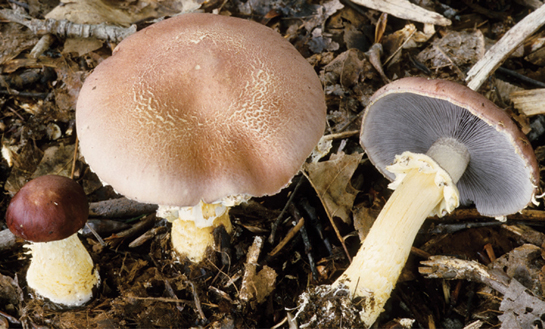
 Stropharia rugoso-annulata (photo credits 1.154)
Stropharia rugoso-annulata (photo credits 1.154)
It is an ideal mushroom for outdoor cultivation, breaking down alder wood chips that are used for garden mulch. When grown with vegetables, the arrangement is complete. The vegetables give needed shade, and the mushrooms provide rich humus for next year’s crop.
The mycelium produces buttons after eight to ten weeks, with the full-grown mushrooms following in another week. Yields of two to three pounds per square foot over eight weeks can be expected. Fruit bodies are produced between fifteen and twenty-one degrees Celsius (fifty-nine to seventy degrees Fahrenheit)—a considerable range and a low temperature for commercial mushrooms, making it ideal for northern temperate climates.
In Hungary, the king stropharia is grown in rows of baled wheat straw simply wetted down and inoculated.
Domestication of the winecap was first proposed for Germany by Puschel in 1969. Since that time, many refinements have been suggested for the cellulose substrate necessary for optimal growth. Because of the high levels of soluble nutrients, the substrate must be presoaked in hot water. The yields, up to 220 grams per kilogram, are higher and more regular than when conventional substrates are used. By contrast, corn stalk yields were poor, with higher contamination rates.
Fruiting and yields were greatly increased when wheat straw was enhanced with 30 percent Lolium perenne grass chaff. This is believed due to beta-adenosine identified in methanol extracts. When twelve milligrams of beta-adenosine was added to one kilogram of wet wheat straw, the fungi fruited eighteen days earlier than the pure wheat straw control, with a 220 percent increase in yield. When twenty-five milligrams was used, the yield increased by 258 percent (Domondon et al. 2004).
Paul Stamets found these mushrooms were a good companion for corn in Washington State.
Preparations of extracellular manganese peroxidase from Stropharia rugoso-annulata have been found to rapidly convert and breakdown the explosive amino nitro-toluenes.
A study by Steffen et al. (2002) found the mushroom to be an efficient degrader of benzopyrene, polycyclic aromatic hydrocarbons, and other toxins, especially in the presence of manganese, which may stimulate the production of manganese peroxidase. The breakdown of these chemicals within six weeks suggests a role in mycoremediation.
Work by Grodzinskaya et al. in Kiev, Ukraine, showed that both water and ethanol extracts of the fruiting bodies are non-toxic (Grodzinskaya et al. 1999). This is good news, as a commercial strain (Gelb, with yellow caps) has long been cultivated in the Ukraine as an edible mushroom. It helps enrich the soil and appears attractive to earthworms and other friends of good ecology. About four million pounds are produced annually in France.
King Stropharia essence brings new insight into what you do. Instead of focusing only on problems and difficulties you now learn to notice the pleasure and nice things in life. This especially when you have seen things the old way for a long time. No more hesitating when you have considered doing things so long, this essence helps you to just do it. Act from your heart, because you like it, not because you need to. Perhaps old traumas made this kind of pleasure disappear from your life, and the outside world still reflects your old soul trauma. The essence grounds and helps you to let go of energies and tension right behind your eyes.
—BLOESEM
The mushroom shows some activity against coliforms, but no serious studies have been yet conducted.
The mushroom contains a human blood type A hemagglutinate.
Suillus grevillei
(TAMARACK JACK)
(LARCH BOLETE)
S. cavipes
Boletinus cavipes
(HOLLOW STEMMED LARCH BOLETE)
S. luteus
(SLIPPERY JACK)
S. granulatus
(MILK BOLETE)
(DOTTED STALKED SUILLUS)
S. tomentosus
(WOOLLY PINE BOLETE)
S. reticulatus
(SUMMER CEP)
S. tomentosus
(POOR MAN’S SLIPPERY JACK)
(BLUE STAINING SLIPPERY JACK)
S. serotinus
S. aeruginascens
S. laricinus
S. viscidus
Fuscoboletinus ssp.
(VISCOUS BOLETE)
S. salmonicolor
S. subluteus
(SLIPPERY JILL)
Slippery jack’s a type of Suillus
You can’t mistake for other fungus.
First remove the slimy cap
Then add to soup, or stews and zap!
A tasty meal with little fuss.
—RDR
Suillus is Latin for “little pig” while granulatus means “dotted.”
Grevillei is named after the English mycologist R. K. Greville. Cavipes means “hollow foot.” Luteus is Latin for “golden yellow,” a misnomer in that it is considerably less yellow than many other species. Tomentosus means “covered with hair.”
If you look carefully, you will see that instead of gills there is a lacy network that some mycologists consider an intermediate stage between gilled mushrooms and the pored boletes.
Tamarack jack is often, as the name suggests, found in tamarack forests. Hollow stemmed tamarack jack is found in the same tamarack or larch woods, but is not slimy and the hollow stalk is noticeable. It is edible but not especially tasty.
Slippery jack is found in the cool of fall and common in northern pine forests. It has even been found in Cotopaxi National Park in the highlands of Ecuador, after hitchhiking in on some imported monterey pine.
It has bright yellow flesh with some red or purple spots.
Slippery jack is a popular dried wild mushroom that is exported in significant amounts from Chile to worldwide markets. It is sold extensively in Europe under the name pine bolete.
Milk bolete is common to mixed or pine forests in summer and fall.
Dotted slippery jack (S. granulatus) is an edible found under jack pine and black spruce.
Poor man’s Suillus contains toxins that largely cook off, but why bother.
Woolly pine bolete is common in the mountains.
Viscous bolete is edible but mediocre. It stains blue.
Suillus are edible when the caps are peeled, but can cause some diarrhea symptoms in many people. All Suillus should have their slimy caps removed to avoid this purgative effect. Many species contain thiaminase, which can create B1 deficiency over time, but more importantly, can trigger swift movement of the bowels.
The Roman Pliny said that “Suilli are dried and transfixed with a rush and are good as a remedy in fluxes from the bowels which are called rheumatisms … and they remove freckles and blemishes on women’s faces. A healing lotion is also made of them for sore eyes. Soaked in water, they are applied as a salve to foul ulcers and eruptions of the head, and to bites inflicted by dogs.”
Tamarack jack and hollow stemmed tamarack jack are added to the traditional Chinese medicine formula called Tendon Easing Powder, which is used to treat lumbago, painful legs, numbed limbs, and discomfort in the tendons and veins.
Slippery jack is used in traditional Chinese medicine to treat Kaschin-Beck disease and is one of the main ingredients in Pine Mushroom Elixir.
 S. grevillei: dibenzofuran, thelephoric acid, and the flavanone, 3’,4,4’-trihydroxy-pulvinone.
S. grevillei: dibenzofuran, thelephoric acid, and the flavanone, 3’,4,4’-trihydroxy-pulvinone.
 S. granulatus: suillusin, suillin, and flazin.
S. granulatus: suillusin, suillin, and flazin.
 S. cavipes: boleletins A-J, 16-hydroxy geranyl geraniol, and cavipetin.
S. cavipes: boleletins A-J, 16-hydroxy geranyl geraniol, and cavipetin.
 S. luteus: suillumide.
S. luteus: suillumide.
Tamarack jack has an inhibition rate of 60 percent against both sarcoma 180 and Ehrlich carcinoma cell lines.
Work by Kamo et al. (2004b) on hollow stemmed tamarack jack identified boleletins A-J, 16-hydroxy geranyl geraniol, and cavipetin, the latter a strong antioxidant with low cytotoxicity.
The related S. lakei is host specific to douglas fir. Keep in mind that douglas fir may be able to form ectomycorrhizae with as many as two thousand different species of fungi.
When found under black spruce, dotted slippery jack markedly reduces the effect of the pathogen Mycelium radicis atrovirens, probably due, in part, to competition for nutrients. It contains suillusin, a unique benzofuran that is probably a derivative of polyporic acid (Yun et al. 2001).
Tringali et al. (1989) identified suillin as the antitumor principle from this mushroom. Both in vitro and in vivo activity against P388 leukemia cell lines was found.
Flazin, a highly fluorescent compound, has been identified recently. It is found naturally occurring in fermented soy sauce.
Slippery jack is used for the same purposes as other Suillus. Inhibition rates are 90 percent and 80 percent respectively for sarcoma 180 and Ehrlich carcinoma.
Suillumide has been isolated from the fruiting body and inhibits the growth of SK-MEL-1 human melanoma cells with an IC50 of ten micrometers (Leon et al. 2008).
Both S. luteus and S. granulatus possess cytotoxic activity against L1210 and 3LL cancer cell lines.
Work by Badalyan (2003) in Armenia found significant antioxidant activity in this mushroom and Pholiota alnicola.
In studies by Geraci et al. (1992) suillin was found to possess significant in vivo antitumor activity against P388 leukemia cell lines.
Suillin, from Suillus placidus of eastern North America, has been found cytotoxic against human liver cancer cells.
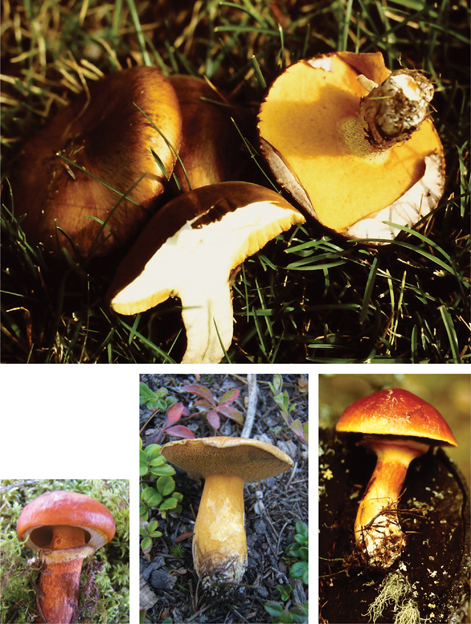
 Clockwise from
Clockwise from
above: Suillus luteus;
Suillus grevillei; Suillus tomentosa; Suillus grevillei
Related compounds in milk bolete include dimethoxysuillin that shows cytotoxic activity against KB cells (human naso-pharyngeal cancer), P388 cells (murine leukemia), and NSCLC-N6 (human bronchopulmonary carcinoma) (Tringali 1989).
Inhibition rate against sarcoma 180 and Ehrlich carcinoma is 80 percent and 70 percent (Ohtsuka et al. 1973).
Four distinct tetraprenyphenols have been identified by Tringali et al. (1989) with two of the compounds possessing antimicrobial activity.
Methanol extracts were found to exhibit significant cytotoxicity against two murine cancer cell lines with an IC50 lower than twenty micrograms per milliliter, for both this species and the related S. luteus.
The related Suillus collinitus shows activity against E. coli, Enterobacter aerogenes, Salmonella typhimurium, Staphylococcus aureus, S. epidermidis, Bacillus subtilis, Candida albicans, and Saccharomyces cerevisiae. The dichloromethane extracts showed higher activity than standard antibiotics (Yamac and Bilgili 2006).
Viscous bolete shows an inhibition rate of 100 percent against sarcoma 180 and 90 percent against Ehrlich carcinoma.
Summer cep (S. reticulatus) essence grounds and anchors us within the strength and power of Mother Earth. It provides energy protection for the entire organism.
—KORTE PHI
Slippery jack (S. luteus) essence brings any unexpressed feelings of shame and guilt up to conscious awareness. It helps release blockages that are caused by deep-seated negative feelings that deny self-worth.
—KORTE PHI
Various Suillus species, including S. grevillei, S. luteus and S. variegatus remove benzo pyrene at a rate of 50 percent in four weeks (Braun-Lullemann et al. 1999).
The latter species degrade TNT under nitrogen-deficient conditions.
Suillus granulatus completely metabolizes catechol, 3,4-dihydrobenzoic acid, and vanillic acid, due to tyrosinase activity. Mycelium transformed para-cresol in just five hours.
Woolly pine bolete is a significant mycoaccumulator of lead by sixty-seven times, and a minor accumulator of mercury by up to six times. It may have a role in mycoremediation of contaminated oil and gas sites, and cleaning up industrial accidents.
Numerous authors have noted the concentration of oxalic acid in Suillus and other ectomycorrhizal fungi when exposed to heavy metals. This appears to be somehow related to disease suppression.
Suillus granulatus shows darkened hyphae when grown on copper-amended media (Gruhn, C. M. and O. K. Miller Jr. 1991). Suillus tomentosus growth was reduced at 370 micrometer levels of soil.
The related S. bovinus can be adapted to zinc-rich soils.
(EARTH FAN)
(COMMON FIBER VASE)
T. vialis
(GROUNDWART)
Thelphora is Greek for “bearing nipples,” due to the warty nature of this leathery genus. It looks at first glance like a Ramaria or Clavaria, but grows on the debris of pine needles.
Earth fan is inedible.
The related groundwart (T. vialis) is used in traditional Chinese medicine as part of Tendon Easing Powder, which is used to treat lumbago, pain in legs, numb hands and feet, and uneasy tendons and veins.
 T. terrestris: terrestrins A-G and pregnanetype steroids terresterones A-B.
T. terrestris: terrestrins A-G and pregnanetype steroids terresterones A-B.
 T. vialis: vialinin A and B, thelephorin A, and ganbajunins.
T. vialis: vialinin A and B, thelephorin A, and ganbajunins.
Earth fan contains terrestrins A-G and pregnane type steroids, terresterones A-B. These compounds exhibit antioxidant activity equivalent or stronger than vitamin C or BHA (Radulovic 2005).
The related T. ganbajun and T. aurantiotincta have been shown to contain various p-terphenyl compounds that show very strong antioxidant properties (Liu, J. et al. 2004).
Thelephantins A-H have been found in T. aurantiotincta.
Thelophoric acid possesses antitumor and anti-allergenic activity.
Vialinin B in T. vialis potently inhibits TNF-alpha production and may be a promising anti-allergenic (Xie, C. 2006).
The IC50 value of 0.02 nanomoles is comparable to the immunosuppressant tacrolimus.
Vialinin A is a powerful antioxidant but also strongly inhibits cytokine production such as TNF-alpha and may have application for treatment of inflammatory conditions such as rheumatoid arthritis. The IC50 is also stronger than tacrolimus, used for organ transplantation.
Vialinin B is a potent inhibitor of TNF-alpha with an IC50 of 0.02 nanomole (Xie, C. 2006).
This eastern North American species also contains various ganbajunins and thelephorin A that possess ten times the antioxidant activity of ascorbic acid (Tsukamoto 2002).
Thompson and Medve (1984) found the fungus tolerant of aluminum and manganese, suggestive of a use in myco-monitoring associated industries. Cadmium inhibited growth at 350 parts per million.
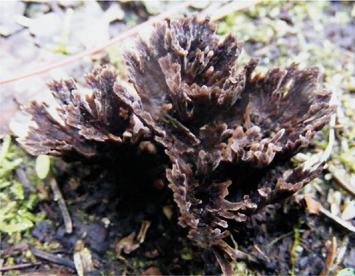
Thelephora terrestris
It degrades 4-fluorobiphenyl by more than 65 percent.
Trametes suaveolens
Boletus suaveolens
Coriolellus suaveolens
(ANISE POLYPORE)
(SWEET TRAMETES)
T. hirsuta
Polyporus hirsutus
Polystictus hirsutus
Coriolus hirsutus
(HAIRY TURKEY TAIL)
T. versicolor
C. versicolor
P. versicolor
(TURKEY TAIL)
(VELVET STALK)
T. cinnabarina
Pycnoporus cinnabarinus
(CINNABAR RED POLYPORE)
T. cinnabarina var. sanguinea
P. sanguineus
(RED POLYPORE)
(VERMILION POLYPORE)
T. pubescens
Tyromyces pubescens
(SOFT TRAMETES)
T. conchifer
Poronidulus conchifer
(LITTLE NEST POLYPORE)
Trametes means “one who is thin” and versicolor means “various colorings.”
Pycnoporus is from the Greek meaning “the pores are close together.” Cinnabarinus means “red,” as in cinnabar red. Suaveolens means “sweet smelling.”
Anise polypore (T. suaveolens) found growing on willow and aspen poplar contains a substance with a pleasant odor reminiscent of anise. The smell is especially evident when the fungus has been cut and is drying. The smell is very similar to that of Haploporus odoratus, a species found only on diamond willow.
It is used by the Laplanders of Finland as an aphrodisiac, due to the spicy fragrance, which is attributed to methyl anisate.
Hairy turkey tail (Trametes hirsuta) is widespread and common. It is a similar, but thinner polypore with variations of gray and a yellow to light brown color.
A related fungus, Trametes versicolor, grows throughout North America. Known as turkey tail, this is one of the most important medicinal mushrooms in the world. It is also known as Coriolus versicolor (a name still preferred by Chinese and Japanese scientists), Polyporus versicolor, and previously Polystictus versicolor. In Japan it is called kawaratake, meaning “mushroom by the riverbank,” while in China, it is called yun zhi or “rain cloud mushroom.”
In Holland, turkey tail is known as elfenbankje, or “fairy bench,” and in Germany, schmetterlingstramete meaning ‘butterfly tramete.”
The fruiting body is fan shaped, resembling a turkey tail, and is blue, brown, gray, and white.
Although not reported in the literature, the mushroom has been found with frequency in Alberta, including several patches by this author.
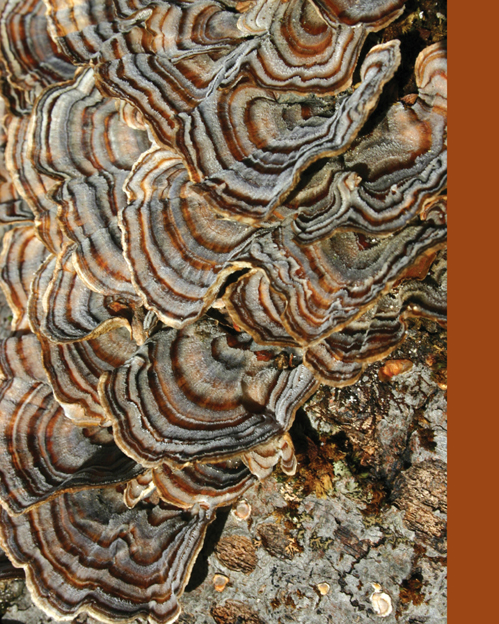
 Trametes versicolor (photo credits 1.157)
Trametes versicolor (photo credits 1.157)
The Dakota were reported to eat the somewhat fibrous fungi. They may have been added to soups and stews and used as a preservative to prevent spoilage.
Cinnabar polypore is named for its intensely bright red color. Cinnabar is derived from the Persian sangarf meaning “red lead” or “mercuric sulphide.” It is known as shutake in Japan.
Trametes, or Tyromyces pubescens, is another shelf bracket that is common on birch and other hardwood trees. It is both smaller and lighter than turkey tail.
Linnaeus, in his 1737 Flora Lapponica, had this to say:
The Lapland youth, having found this Agaric (T. odora), carefully preserves it in a little pocket hanging in front of his pubes, that its grateful perfume may render him more acceptable to his favorite one. O whimsical Venus! In other regions you must be treated with coffee and chocolate, preserves and sweetmeats, wines and dainties, jewels and pearles, gold and silver, silks and cosmetics, balls and assemblies, music and theatrical exhibitions; here you are satisfied with a little withered fungus!
Badham, in A Treatise on the Esculent Funguses of England written in 1847, tells of
a young man of twenty-one, [who] was seized at the beginning of autumn with inflammatory cough and haemoptysis.… But the cough, coming on again with renewed severity during the winter, was accompanied by the expulsion of glairy mucus, which was sometimes specked with blood.
Toward the spring the young man had become much thinner, and was continuing to waste away; the expectoration also had changed in color, and had become fetid and green; his nights were feverish and disturbed; he had no desire for food, and ate but little; his ankles had begun to swell; he had copious night sweats and diarrhea. A teaspoonful of an electuary of the Polyporus suaveolens in honey was given three times a day, and nothing else; and extraordinary as it may appear, under this treatment his sweat speedily began to diminish with the cough, and after three months’ continuance of the medicine the patient entirely recovered.
Anise polypore has been used for night sweats associated with tuberculosis and various other lung ailments.
Porcher reported on several medical cases given up as incurable that recovered. Two drams of the powder were given morning and evening to effect a cure.
Ancient Taoists prized the fungi, partly because they can grow on evergreen pine trees, and therefore must have the staying power of the trees. They believed the fungus collected yang energy from the roots of the tree and prescribed it for patients with yang-deficient energetics.
The polypore is applied topically in Mexico as a treatment for impetigo and ringworm.
In China, the polypore is used medicinally for increasing circulation and clearing heat and damp. It is often prescribed by herbalists in rheumatism and to cure fevers.
Cinnabar polypore is dried and powdered as a styptic.
The fungi are used in Malaysia for skin complaints including acne, probably due to the plant signature of red for inflamed skin and blood problems.
In Johore, it is powdered and added to eau de cologne to heal leprous tubercles, according to Hobbs. His book, Medicinal Mushrooms, has been a great inspiration to me in my own exploration of local species.
It is decocted and used as a wash for eczema, and extracted in warm oil for knotty swellings.
According to Ying et al. (1987), cinnabar polypore was used traditionally for its hemostatic and anti-inflammatory properties.
Hairy turkey tail is used in traditional Chinese medicine to dispel wind and damp, cure lung disease, stop coughs, resolve suppurations, and promote the growth of muscle.
In traditional Chinese medicine turkey tail is considered sweet and slightly warming, entering the spleen and heart meridians. It is used for infection and inflammation of the upper respiratory, urinary, and digestive tracts. The mushroom is used to increase energy and stamina, and benefits patients with hepatitis B and chronic active hepatitis. It can be used for general immune weakness and tumors.
In Mexico, Trametes or Tyromyces pubescens is used to cure ringworm and impetigo of the skin.
The red or cinnamon polypore is recommended in traditional Chinese medicine for reducing fever, swelling, and dampness, and as an antidote for toxins.
Decoctions are used for arthritis, rheumatism, and gout, as well as fungal disease.
In Malaysia, where it is known as Chendawan Merah, the fungus is used to treat dysentery.
A powder is made for external application to wounds to stop bleeding and prevent infection.
The fungus is said to invigorate vital energy, improve blood circulation, and stop skin itching. It is said to promote muscle growth.
Aborigines of Australia sucked on the polypore to treat sore mouths; they also rubbed it inside babies’ mouths to treat oral thrush and to alleviate pain from teething.
 T. versicolor: PSK (polysaccharide krestin), PSP (polysaccharide peptide), lipids (1.7 percent) containing ergosta-7,22,dien-3(ol), a major sterol of many polypores, as well as ergost-7-en-3(ol) and ergopsterol (provitamin D2), polyhydroxysteroids, cerevisterol, tetraol, sitosterols, coriolan; 3 beta, 5 alpha, 9 gamma-trihydroxyergosta-7,22-dien-6-one, 11 percent protein, 76 percent complex carbohydrates, and various B vitamins and minerals.
T. versicolor: PSK (polysaccharide krestin), PSP (polysaccharide peptide), lipids (1.7 percent) containing ergosta-7,22,dien-3(ol), a major sterol of many polypores, as well as ergost-7-en-3(ol) and ergopsterol (provitamin D2), polyhydroxysteroids, cerevisterol, tetraol, sitosterols, coriolan; 3 beta, 5 alpha, 9 gamma-trihydroxyergosta-7,22-dien-6-one, 11 percent protein, 76 percent complex carbohydrates, and various B vitamins and minerals.
 P. cinnabarinus: cinnabarin, cinnabaric acid, and tramesanquin.
P. cinnabarinus: cinnabarin, cinnabaric acid, and tramesanquin.
 T. versicolor and P. sanguineus: 4-hydroxymethyl-quinoline.
T. versicolor and P. sanguineus: 4-hydroxymethyl-quinoline.
 T. versatilis: 1 percent eburicoic acid.
T. versatilis: 1 percent eburicoic acid.
 T. menziesii: trametenamides A and B.
T. menziesii: trametenamides A and B.
Turkey tail has been widely studied in China and Japan for its immune-stimulating polysaccharides and its use in the treatment of cancer. More than four hundred clinical studies have been published in Japan in the past thirty-some years, showing benefits to the immune system, with or without chemotherapy and radiation.
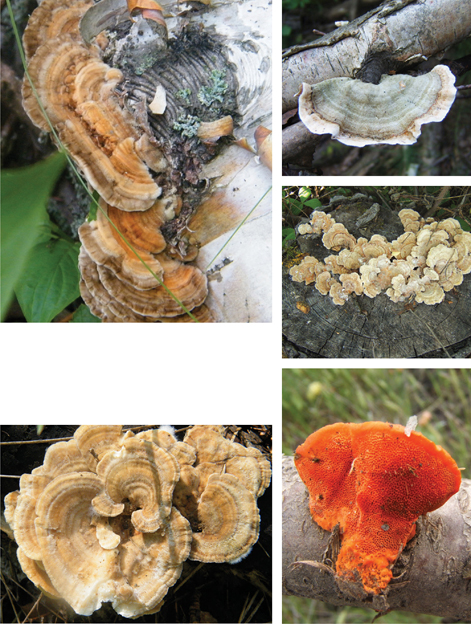
 Clockwise from above: young Trametes hirsuta, older Trametes hirsuta, Trametes pubescens, Pycnoporus cinnabarinus, Trametes pubescens.
Clockwise from above: young Trametes hirsuta, older Trametes hirsuta, Trametes pubescens, Pycnoporus cinnabarinus, Trametes pubescens.
In 1987, more than 25 percent of the money spent on natural anticancer agents in Japan, were for PSK, a polysaccharide fraction of turkey tail. The P is for polysaccharide and K is the first letter of Kureha, the company that developed both PSK and Krestin.
Another active component is a protein bound polysaccharide (PSP) consisting of six kinds of monosaccharides, glucose, mannose, galactose, xylose, arabinose, and rhamnose connected with a small molecular protein polypeptide.
Krestin was the first mushroom-derived anti-cancer drug approved by the Japanese government, and all healthcare plans in that country cover its cost.
In 1965, a chemical engineer working for Kureha Chemical Industry Company observed a neighbor taking the remedy to cure himself of gastric cancer. He was in the late stages and had been rejected for treatment at all clinics and hospitals. He took the treatment for several months and then went back to work. The engineer convinced his workers to investigate the mushroom. The success of Krestin inspired Chinese researchers to look into other extracts, and they developed PSP, or polysaccharide peptide, from a different culture strain.
PSK is a water-soluble protein-bound poly-saccharide with 1,4 glucan as a main component, 1,3 glucan linkages, and 38 percent protein. PSP is 10 percent peptide and 90 percent polysaccharides. It lacks fucose, but contains arabinose and rhamnose, which PSK does not have. They are quite different.
To manufacture PSP, the PSK is precipitated with alcohol to reduce the protein links to peptide links. The glucan structures are left unchanged.
Coriolan is an antitumor polysaccharide that does not contain any nitrogen. This reminds me of the sundew, venus fly trap, and other carnivorous plants that trap insects for survival in nitrogen-depleted bogs and swamps. These nitrogen-deficient herbs are also used for treating cancer.
PSK improves the function of blood vessels, normalization of spleen index, immune enhancement, and possible prevention of liver cancer. It prolongs the activity of antibiotics and increases sensitivity in antibiotic-resistant bacteria, working in a synergistic manner in cases of MRSA and other resistant strains.
PSK, derived from mycelium, is immune enhancing, and has broad neoplastic activity. It has been shown to restore antibody (IgG) production in mice with sarcoma 180, but not in normal mice.
It acts directly on tumor cells, prevents metastasis, and enhances the effects of radiation or chemotherapy. It stops the spread of tumors by disabling enzymes that allow tumor cells to break out of the matrix that holds healthy cells in place. This is very useful in radiation therapy for endometrial cancer.
PSK is antiviral, inhibiting HIV by either modifying the viral receptor or stopping HIV from binding with lymphocytes. It also stimulates interferon production.
One study found thirty-six patients with chronic fatigue syndrome who took the mushroom supplement for two months showed a 35 percent increase in natural killer cells.
Dr. Andrew French reported a case study of a pregnant patient whose chronic genital herpes were alleviated with turkey tail mushroom extracts.
PSP is immune stimulating, and although similar to PSK, it has no fucose, while PSK has no rhamnose or arabinose. At least sixteen papers have examined the ability of PSK or PSP to stimulate immune cells or inhibit cancer cell proliferation. More than forty studies have looked at their ability to inhibit metastasis, angiogenesis, and/or tumor growth in animal studies.
PSP has been found to alleviate symptoms and prevent decline in immune status.
Thirteen studies looked at interactions with radiation or chemotherapy, or the ability to decrease immunosuppression caused by these therapies. Fifty-four studies focused on their ability to inhibit cancer progression in humans.
Twenty-four randomized controlled, multi-centered trials found adding PSK to treatment regimes improved patient survival rates.
PSP induces gamma interferon, interleukin-2, and T-cell proliferation.
In tumor-bearing mice, PSP has been shown to stop thymus atrophy and increase IgG values. It has shown tumor-inhibiting activity in animals with sarcoma 180, P388 leukemia, human lung carcinoma, and various cancers of the liver, stomach, nose, and throat.
In one study of 185 patients with stage III lung cancer, the five-year survival rate for those who received radiation and PSK exceeded the radiation-only survival rate by 400 percent (Hayakawa 1993).
In colorectal cancer, it checked advancement and increased survival rate in a trial involving 221 patients treated with mitomycin. PSK reduced the depth to which the cancer invaded the intestinal wall and curtailed its spread to lymphatic nodes and blood vessels.
In one randomized study, 111 patients with curatively resected colorectal cancer received either chemotherapy or chemotherapy plus PSK. The latter group increased the eight-year survival rate from 7.8 percent to 28 percent and the ten-year survival from 19 to 36 percent.
Work with 124 gastric cancer patients showed similar benefit (Nakazato et al. 1994).
Patients without cancer but suffering from leaky gut syndrome may also benefit.
In a pilot study of thirteen patients, nine improved and one patient with hypothyroid made a full repair of tissue in only three months.
One study found PSK increased the survival rate of seventy-four patients receiving a chemotherapy combination of 5-fluorouracil, cyclophosphamide, mitomycin C, and prednisolone following breast cancer surgery.
A recent discovery is that PSP exhibits S-phase cell cycle arrest-specific activity, in addition to immune modulation (Hui 2005).
Reduction of toxicity from radiation and chemotherapy accounts for much of the extract’s popularity.
One glycoprotein from turkey tail shows activity against hypertension, diabetes, thrombosis, and rheumatism. The protein inhibits blood platelet aggregation and exhibits analgesic, antipyretic, anti-hyperlipemic, anti-arrhythmic, anti-inflammatory, and vasodilating activity.
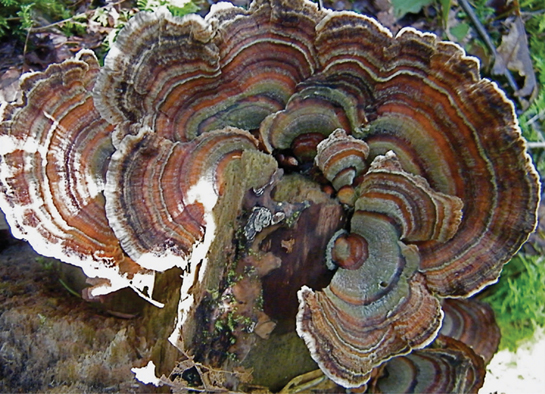
Studies by Ikuzawa (1985) showed that it reverses conditions associated with nephron (kidney) disorders, including proteinuria and proteinemia, and regulates prostaglandin formation and degradation.
The whole mushroom has been shown to lower serum cholesterol and in combination with Astragalus root (A. membranaceus) enhances neutrophil function and speeds recovery from burns.
Numerous human clinical trials have been conducted on PSK and have shown it to be effective against many human cancers.
PSK reduces cancer metastasis by inhibition of tumor invasion, adhesion, and the production of cell-degrading enzymes. It suppresses tumor cell attachment to endothelial cells by inhibiting platelet aggregation and tumor cell migration by limiting motility. It suppresses tumor growth by inhibition of angiogenesis.
Ethanol extracts of the fungus show promise as an adjunct therapy for prostate cancer, by slowing tumorigenesis (Hsieh, T. C. and J. M. Wu 2001).
A 1982 study on the survival rate of cervical cancer patients in Tokyo showed that PSK, when given orally with radiation, showed no tumor cells in 36 percent of patients as opposed to 11 percent in the control group.
The two-year survival rate was 94 percent with PSK, and 74 percent without. The rate of cancer deaths within five years was 21 percent with PSK, and 52 percent without.
A year-long double-blind study of human papilloma virus and cervical dysplasia involving forty-three patients showed a 72 percent decrease in low-grade squamous intra-epithethial lesions compared to a control group at 47.5 percent. Dosage was three grams daily.
One ten-year study of 185 lung cancer patients who underwent radiation showed that stage I or II patients taking Krestin had a 39 percent survival rate compared to placebo at only 16 percent. Those with stage III showed 22 percent survival rate in the Krestin group and only 5 percent in the control group.
A randomized, controlled clinical trial of 227 patients with breast cancer involved one group taking PSK and chemotherapy, the other chemotherapy only. The ten-year study found an 81.1 percent survival rate in those taking PSK, compared to 64.5 percent in the control group receiving only chemotherapy.
Improved symptoms have been observed in patients suffering systemic lupus, chronic rheumatoid arthritis, sclerosis, Bechet’s disease, and other autoimmune disorders, suggestive of immune modulation.
The polysaccharides enhance alkaline phosphatase in osteoblast cells, suggesting use in osteoporosis and degenerative bone disease.
In melanoma, it reduces the rate at which cancer cells spread to the lungs and increases the effectiveness of cyclophosphamide and interleukin-2.
In ovarian cancer, it helps maintain the body’s own production of IL-2.
It appears that PSK in higher concentrations (five to eleven micromoles) inhibits cancer cells, due to hydrogen peroxide produced when SOD activity is increased (Kobayashi, Y. et al. 1994a, 1994b, 1994c).
This increased production of SOD and hydrogen peroxide may explain PSK induced enhancement of cisplatin activity against cancer cells in vitro (Kobayashi, Y. 1994d).
PSK stops the invasion of normal cells by leukemia cells, and reduces the likelihood of relapse in childhood acute lymphocytic leukemia after chemotherapy is discontinued.
One study found that PSK cured both primary and metastatic tumor in a double-grafted tumor system.
When given as a maintenance therapy with 6-mercaptopurine, fourteen patients with various leukemias increased survival times or had complete remission (Nagao, T. et al. 1981).
A controlled clinical trial on PSP was conducted on 485 patients with cancer of the esophagus, stomach, and lungs. The PSP group suffered fewer side effects of conventional therapies such as pain, poor appetite, tiredness, weakness, and dryness of the mouth and throat. Body weight remained higher, as did T-cell ratio, natural killer cell activity, and IL-2 levels (Yang, Q. Y. 1999). The rate of remission in esophageal patients receiving PSP was 72 percent, compared to a control group receiving chemotherapy only, which showed a remission rate of just 42 percent.
A ten-year clinical trial involving fifty-six post-surgery colon or gastric cancer patients receiving PSP evaluated the patients every three months. Their survival rate was considerably higher than the fifty-five patients in the control group who received a placebo.
In a study by Shiu W. C. T. et al. (1992) breast cancer patients treated with 4’epidoxorubicin and cyclophophamide, the addition of PSP stabilized and practically prevented white blood cell decreases due to chemotherapy. The poly-saccharide peptide (PSP) taken three times daily prevented a significant drop in white blood cell count following three courses of chemotherapy when used as pre-treatment in eleven patients and taken with vincristine, cyclophophamide, and 4’epidoxo-rubicin in human clinical trials.
Animal trials suggest significant restoration of immune-suppressing effects of cyclophosphamide.
The polysaccharopeptide PSP also suppresses the expression of vascular endothelial cell growth factor associated with anti-angiogenesis and antitumor growth.
The oral LD50 of PSP is ten milligrams per kilogram, with no toxicity or side effects reported.
Turkey tail is effective when kidney or liver function is impaired, as about 70 percent of the break-down products is excreted through the lungs.
Jeng-Leun Mau et al. (2002) found turkey tail possesses some antioxidant properties, but it is only one-third as powerful as Ganoderma tsugae.
Mikiashvili et al. (2004) found T. versicolor shows high carboxymethyl cellulase (4.29 units per milliliter) and xylanase activity (5.54 units per milliliter).
Polysaccharide extracts were found to increase macrophages 7.2-fold over controls (Jeong, S.-C. et al. 2006).
Methanol extracts of turkey tail also exhibit activity against B16 melanoma cells. Extracts have been found to be directly cytotoxic and anti-proliferative to tumor cells and indirectly via macrophage activation.
Hairy turkey tail (T. hirsutus) possesses anti-tumor and anti-neoplastic activity (Jong and Gantt 1987).
It inhibits sarcoma 180 in white mice by 65 percent (Ikekawa et al. 1968).
Studies indicate that red polypore is active against sarcoma 180. This could be due in part to the significant content of organic germanium (eight hundred to two thousand parts per million) in this shelf fungus.
It is considered an antidote for toxins and is used for arthritis, including gout, as well as for antibacterial and antifungal activity.
Trametes sanguinea is used in the alkaloid transformation of thebaine to 14-hydroxy-codeinone with a 40 percent yield. Theabaine poppies are being developed in Canada to replace dependency on sources from Afghanistan. It is easy to transform thebaine into morphine and codeine but extremely difficult to produce heroin.
The cinnamic acid ester of this product is 177 times more potent than morphine as an analgesic and five hundred times as potent as morphine in a test involving pentobarbitol potentiation of grip on a forty-five degree plane.
The cultured red or cinnamon polypore mycelium, which contains polyporin, as well as water extracts of the fruiting body, have been found active against Staphylococcus aureus, S. albus, Streptococcus salivarius, Pseudomonas aeruginosa, Salmonella paratyphi, E. coli, Klebsiella pneumoniae, Vibrio cholerae, and Shigella paradysenteriae.
Callow and Chain, in unpublished work, identified polystictin as active against S. aureus.
Water extracts show antitumor activity in vitro. Inhibition rates against sarcoma 180 are up to 90 percent.
Both T. versicolor and T. sanguineus contain an unoxidized quinoline compound, which is active against malaria (Abrasham and Spassov 1991).
Silva et al. (2009) found activity against chloroquine-resistant Plasmodium falciparium, as well as inhibition of nitric oxide and immune-modulating activity.
Cinnabarin acid shows activity against gram-positive bacteria including Streptococcus species. Cinnabarin is antibacterial, antifungal, and antiviral. It has a basic ring-like structure similar to acitomycin D, an antibiotic used in cancer treatment. Cinnabarin at only 0.31 milligrams per milliliter reduced the rabies virus levels by four-fold (Smania, A. et al. 2003). It does not cause any toxic effects in mice at concentrations of one thousand milligrams per kilogram.
Meyer described an antibiotic substance from T. cinnabarinus that inhibited bacteria at a concentration of one part in five thousand. It was active against Staphylococcus and Streptococcus species.
The fruiting bodies of P. cinnabarinus have antibacterial activity. The mycelium showed activity against Bacillus subtilis.
Cultured fluids also show activity against Streptococcus species, due in part to the content of cinnabarinic acid, mentioned above.
Culture filtrate of the fungi is active against E. coli and Pseudomonas aeruginosa, as well as Staphylococcus aureus and various plant pathogenic fungi.
Early work found polysaccharides from the mycelium culture inhibit sarcoma 180 and Ehrlich carcinoma cell lines by 90 percent (Ohtsuka et al. 1973).
T. conchifer has been shown to possess antitumor polysaccharides in the polypore.
The related T. gibbosa has an inhibition rate of 49 percent against sarcoma 180 with both hot-water and ethanol extracts. It is a very strong inhibitor of both 1 kappa B-alpha degradation and phosphorylation.
Trametes versatilis, in the form of cultured mycelia, produces 1 percent eburicoic acid (Ma, B.-J. et al. 2007).
Trametes menziesii contains two ceramides, trametenamides A and B. The former is cytotoxic to SK-MEL-1 cells at low concentrations due to apoptosis. Ceramides induce self-programmed death in cells by permeabilization of the mitochondrial membrane, which allows the exit of pro-apoptotic factors such as cytochrome (Leon et al. 006).
The inhibition rate of a hot-water and ethanol extract of Trametes or Tyromyces pubescens on the growth of sarcoma 180 is 59.5 percent (Shibata, S. et al. 1968).
Lau et al. (2004) found water and alcohol extracts of the fungus inhibit the proliferation of lymphoma and leukemic cells by apoptosis, or programmed cell death.
The fruiting body and mycelium exhibits activity against various bacteria, including Staphylococcus aureus, Enterobacter aerogenes, Pseudomonas aeruginosa, and the yeast Saccharomyces cerevisiae (Yamac and Bilgili 2006).
Picnoporus sanguineus is related to irritability and feelings of frustration, accompanied by an aversion to company. There may be dreams of violence and arguments, irritability accompanied by sadness, feelings of self-doubt, mistakes and awkwardness.
Dreams of aliens and danger, and a pervading sense of fear upon waking.
Sharp stabbing pains, dull headache, and numbness also present.
The most striking of all the skin symptoms was the intolerable itch, like fleabites, but no amount of superficial scratching relieved it.
Peculiar symptoms include sneezing after bath, sensation of the scalp being pulled up, and pain upon smiling.
Dose: 30 C. Provings were done by Catherine Anne Morris in South Africa on thirty people in 2002. The C4 trituration trials were conducted on six people in Brisbane, Australia, and ten people in Stockholm, Sweden.
—VERMEULEN
The bracket fungus from poplar, Trametes suaveolens, yields an essential oil from steam distillation that contains amanitol, which is also present in Amanita muscaria. It contains anisaldehyde and 78 percent methyl anisate, which gives a licorice fragrance.
The related T. odorata is slightly anise-like, but also scented like rose, honey, and fruit. It contains methyl phenylacetate, geraniol, nerol, and citronellol.
Turkey tail (Trametes versicolor) essence helps bring you face to face with love and nurturing all parts of yourself, all parts of you belong. A part of you is to be discovered and given face, helping you find a greater whole.
—CANADIAN FOREST
Turkey tail essence is for the eternal worrier, for those who need to ground their energies into the physical world and for those who work with nature. It is for low energy, immune problems, vision, diabetes, rheumatism and lungs.
—SILVERCORD
Trametes versicolor essence increases our capacity for self-awareness, helping us through difficult crises and at key transition points in our life. It helps us recognize outside influences for what they are, protecting us against parasitic energies when we are vulnerable.
—KORTE PHI
Turkey tail essence works through the energy circuits that influence the chemical structures holding the imprint of childhood abuse or trauma at the cellular level. Use it when you are ready to break down and release the patterns and memories of childhood abuse or trauma. Holding onto these energies can lead to physical symptoms such as fibromyalgia or autoimmune disorders, or emotional symptoms such as fear, powerlessness or disassociation.
—TREE FROG
Cinnamon red polypore is for inner transformations, and for creating a synergy between the many aspects of your being and personality. The essence will aid your work with guides and teachers, as you are able to translate the information more easily and directly in the conscious mind.
—CANADIAN FOREST
Red polypore (P. sanguineus) essence has a strong grounding effect as it stimulates the root chakra. It strengthens our connection to the earth and promotes better circulation in the lower extremities especially the feet.
—KORTE PHI
Turkey tail essence supports necessary demarcation against foreign influence and prevents seizure of social personality. It prevents spread of negative mood in social fabric and for those who think we should all do exactly the same thing. It is anti-bullying essence.
—MARIANA
Cinnabar polypore essence promotes inner transformation and changes. The essence helps bring things from the subconscious to surface to get into conscious mind and help integrate into everyday life.
—MARIANA
For T. pubescens, laccase production is best stimulated by xylidine. It also tests very high in lipase activity, suggesting application in a variety of oleochemical, petrochemical, and biodiesel applications (Goud et al. 2009).
Turkey tail was identified as far back as 1963 as a lignin degrader. One study found this fungus to be the most powerful degrader of 3,4-dichloroaniline, dieldrin, and phenanthrene.
Another study found that the dose of PCP per mycelium mass, rather than a concentration in the medium, regulated the growth and myco-degradation. T. versicolor was found to be the best at both PCP resistance and its degradation.
Turkey tail produces peroxidase enzymes, which quickly break down wood lignins. It has been studied for the pulping of wood and the degradation of aromatic hydrocarbons. Black and Reddy isolated six genes responsible for lignin peroxidase production.
It is still considered the most effective fungi to combat lignin and chlorine-containing effluent.
Kwang Soo Shin and Yeo Jin Lee (2000) identified an extracellular peroxidase that works optimally at pH 3 and between fifty and sixty-five degrees Celsius (122 and 149 degrees Fahrenheit).
Various researchers have shown that secondary metabolites from the mycelium break down polycyclic aromatic hydrocarbons including antracines, pyrenes, flourene, methoxybenzene, and styrene. One study found heat-sterilized mycelium absorb mercury ions from water systems.
It absorbs chromium from wastewater.
One study found both T. versicolor and Tyromyces palustrin metabolize dibenzyl sulphide to benzyl alcohol and benzyl mercaptan.
Chlorophenols up to two thousand parts per million can be effectively remediated with turkey tail. One study found immobilizing the white rot basidiomycete in nylon mesh created far greater efficiency. The idea is worth investigating for pulp and paper, as well as pharmaceutical wastes. The nylon mesh is fixed to a metal frame around the perimeter of bioreactor and replaced at intervals, and so on. Brilliant.
Fragoeiro and Magan (2008) suggest that the mushroom has the ability to degrade different groups of pesticides. Complete degradation of dieldrin and trifluralin, as well as 80 percent of simazine, were observed.
One study found free cell cultures of the mushroom in nylon mesh helped remove PCP and 2,4-dichlorophenol, via laccase and manganese peroxidase.
Black liquors from a soda pulping mill were treated with the fungus in the form of pellets in aerated reactors, and showed reductions of 70 to 80 percent in color and aromatic compounds, and 60 percent in chemical oxygen demand.
Soil contaminated with PCP responded well to inoculation by the fungus (Tuomela et al. 1998).
Turkey tail laccase was able to oxidize 35 percent of anthracene in only seventy-two hours.
Itmura et al. (1997) identified two genes induced by exposure to PCP.
Work by Zorn et al. (2003) found beta-ionone to be the main metabolite from submerged culture with beta, beta-carotene.
Turkey tail has great promise in mycoremediation, with burlap sacks filled with sawdust or wood chips and mycelium, able to filter heavy metals, organophosphates, PAHs, pesticides, and various microbes including E. coli, Listeria monocytogenes, and Candida albicans.
Hairy turkey tail shows promise in conversion of dioxins, enzymatic decolorization of melanoidins, and oxidation of phenols, like its more famous cousin. Co-cultivation with Cerrena maxima showed oxidation of the phenolic component of lignins from birch sawdust.
Various Trametes species, including T. hirsutus and T. villosa, can help mycofilter chemical and color dyes.
One study found laccase from this species has some superior characteristics such as high stability, high activity, and low carbohydrate content.
Hairy turkey tail, in liquid cultures, shows potential to degrade DDT, aldrin, dieldrin, lindane, and heptachlor.
It breaks down waste from wool clothing production.
Earlier work found a purified laccase-degraded triarylmethane, indigoid, azo, and anthraquinonic dyes.
Van Hamme et al. (2003) identified T. hirsuta and Funalia trogii mycelicum as helping to metabolize dibenzyl sulphide.
Cinnabar polypore has been studied for its ability to hydroxylate biphenyl and diphenyl ether.
Purified laccase broke down the chromophore of Chicago Sky Blue dye in the presence of oxygen.
This laccase transforms benzo[a]pyrene in the presence of ABTS.
Increasing apramycin sulfate concentrations enhanced laccase production. Pointing et al. (2000) found increased laccase production in submerged liquid culture fifty-fold from P. sanguineus in the presence of twenty micromoles xylidine.
Red polypore (T. sanguineus) absorbs heavy metals from water solution using a fixed-bed column, removing more than 90 percent of lead, copper, and cadmium.
Both T. pubescens and T. sanguineus are useful for breaking down lignins for industry.
Turkey tail is prized in the Far East for cosmetic purposes as well as treating areas of weak connective tissue, massage formulations, acne, and irritated erythema due to excessive ultraviolet sun radiation. Suggested applications include sunscreen or after-sun products as well as acne and anti-cellulite creams.
Cinnabar polypore is rich in protease enzymes, suggesting not just anti-inflammatory application but use in detergents, cheese making, meat tenderizers, flavor development, and the leather industry (Goud et al. 2009).
Cinnabar polypore and sugar beets have an unusual relationship. Beet pulp is rich in the precursors rhamnose and ferulic acid that through microbial bioconversion form vanillin. Ferulic acid is first released by enzymes and specific ferulic acid esterases, and then biotransformed into vanillin by the selected fungi, or a two-step process first using Aspergillus niger to transform ferulic acid into vanillic acid, and then cinnabar polypore to obtain vanillin from vanillic acid. Vanillin, of course, can be easily converted into vanilla, the world’s most popular food flavor. It also has uses in the pharmaceutical and perfume industries.
The biological transformation of high-value food flavors from agricultural by-products is an ongoing and interesting area of study. This natural biotech vanillin has high economic potential, with utilization of approximately fifty to one hundred tons per year for high quality chocolates, ice cream, and pastries.
One study looked at laccase from this fungus for food preparation. An infusion of green tea for a beverage drink was improved significantly by incubating with Pycnoporus laccase.
Both P. cinnabarinus and P. sanguineus produce tryrosinase, which has applications for the food additive industry.
It has been found to increase maximum resistance of wheat flour dough.
The addition of ethanol increases laccase activity from the culture medium as compared with ferulic acid induced cultures. High quality flax pulp can be bleached in a totally chlorine-free method using this laccase. Vanillic acid is transformed by the fungus and produces crystalline vanillin from autoclaved corn bran without any purification step.
The multicolored fans of various Trametes have been used worldwide in art, earrings, necklaces, ancient weapons, and articles of clothing.
The dried fungus is used to dye wool a grayish yellow color, without mordant.
Up to twenty grams of turkey tail three times per day brewed as a tea.
In powdered form (in capsules), take up to five grams PSK per day before or between meals. Some patients experience a darkening of the fingernails as a side effect of PSK.
Take one-gram PSP capsules three times per day.
Optimal extraction of polysaccharides is best accomplished by crushing into a powder and then boiling at one hundred degrees Celsius (212 degrees Fahrenheit) for eighty minutes and extracting three times from the same marc.
T. lutescens
(YELLOW WITCH’S BUTTER)
(FAIRY BUTTER)
(STAR JELLY)
(YELLOW BRAIN JELLY)
T. foliacea
(BROWN WITCH’S BUTTER)
(LEAFY JELLY FUNGUS)
T. glandulosa
Exidia glandulosa
E. intumescens
E. spiculosa
(BLACK WITCH’S BUTTER)
(BLACK JELLY ROLL)
Dacrymyces palmatus
D. chrysospermus
(ORANGE JELLY FUNGUS)
T. helvelloides
Phlogiotis helvelloides
Guepinia helvelloides
(APRICOT JELLY)
(SALMON SALAD)
Star jelly is named for the one-time belief that it was the remains of a meteor shot from the stars. In fact, the first fifteenth-century English encyclopedia, by William Caxton, mentions this link.
The Mirror of the World, translated from a French manuscript of 1464 and, in turn, from a copy of the Latin dated 1245 AD, discusses shooting stars … “and when they come where it is fallen, they find none other things but a litl asshes or like thing some leef of a tree roten, that were weet.”
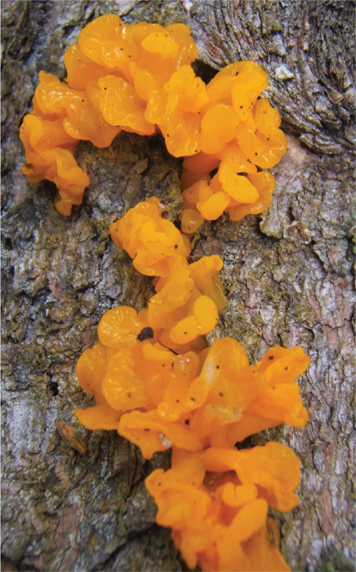
 Dacrymyces palmatus
Dacrymyces palmatus
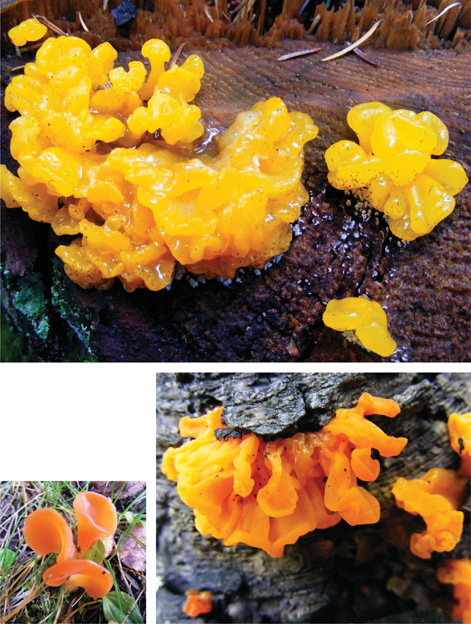
 Clockwise from above:
Clockwise from above:
Tremella mesenterica;
Dacrymyces palmatus;
Phlogiotus helvelloides.
John Donne wrote, in a seventeenth-century poem:
As he that sees a starre fall, runs apace.
And finds a gellie in the place,
So doth the bridegroom hast as much
Being told this starre is faine, and finds her such.…
Ernst Chaldni, at the turn of the eighteenth century, was even bolder, suggesting jelly mushrooms were extra-terrestrial.
Yellow witch’s butter looks like bright yellow-orange, brain-like lobes thrown onto dead poplar and other hardwoods and sticks. Thompson natives of British Columbia call this fungus “product of tree coming to be split open.” It is edible, once you get over the idea that something that bright and unusual looking can be eaten. It is jelly-like when wet, and small and hard when dry.
Brown witch’s butter is brown, flabby, and gelatinous, often found on fallen white spruce. It is not recommended for eating but is used medicinally.
Orange jelly (Dacrymyces palmatus) looks similar and is found on spruce trees. As the name suggests, it is more orange in color and has Y-shaped basidia and two long narrow spores that develop cross walls. Tremella species have four spored, longitudinally septate basidia.
The related D. stillatus (D. deliquescens) is somewhat smaller. This species, along with Piptoporus betulina, Panellus stipticus, and Auricularia auricula immediately re-adjusted their spore discharge periods when light and dark cycles were reversed. Artist’s conk (Ganoderma applanatum), in contrast, took forty-eight hours to readjust.
Black witch’s butter is found on hardwoods including poplar and birch, but I have also seen it on decaying pine in late fall.
The mycelium of the related T. aurantia, harvested from liquid culture, is added to walnut cakes, biscuits, noodles, and breads in China.
The related silver ears or white jelly fungus (T. fuciformis) is the only mushroom in the world that is considered a dessert food. It is known as yin er in China, hakumokuji in Japan, and baekmoki in Korea.
Tremella is used in traditional Chinese medicine to relieve inflammation of the upper respiratory tract and is soothing, demulcent, and slightly expectorant.
Yellow witch’s butter was rubbed on chilblains in parts of England.
The related silver ears or white jelly fungus (T. fuciformis) has been used medicinally since the sixteenth century, as a tonic for vigor and longevity. In Japan, the fungus is eaten to prevent atherosclerosis, by lowering total blood cholesterol levels, and maintaining levels in the linings of cells, where it is most needed. The powder is used in cholesterol-controlling functional foods and drinks.
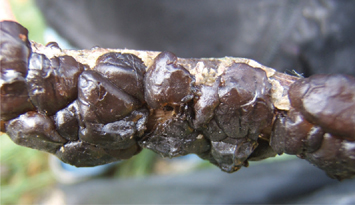
 Exidia glandulosa
Exidia glandulosa
It moistens the lungs and helps generate fluids, making it useful for treating a dry, nonproductive cough due to lung yin deficiency.
During Midsummer’s Eve in Sweden, bonfires with nine different woods are lit. Witch’s butter, known as trollsmor or “troll’s butter,” is tossed into the flames to thwart evil spirits.
When the fungus was found near animals, it was customary to burn it in fires, to force a troll to appear and beg for mercy from thirst created by the heat of the flames.
 T. mesenterica: glucurmomannan 1,3-alpha-glucan; epitope (beta-D-glucuronosyl), 1,3-beta-1,6-beta glucan, chitin, xylose, mannose, glucurmic acid, and a trace of galactose.
T. mesenterica: glucurmomannan 1,3-alpha-glucan; epitope (beta-D-glucuronosyl), 1,3-beta-1,6-beta glucan, chitin, xylose, mannose, glucurmic acid, and a trace of galactose.
Mice trials of T. aurantia indicate benefit in lowering cholesterol and treating coronary disease.
Tremella is an expectorant for the lungs, widely used in medicine for bronchial inflammation and asthma. It has a comparative immunological profile to type II anti-pneumococcal serum.
It contains a pheromone mating scent, tremerogen A-10, which is of interest.
Yellow witch’s butter (T. mesenterica) has a wide range of medicinal value, including immune stimulation, radiation protection, and anti-diabetic, anti-inflammatory, hypocholesterolemic, hepato-protective, and anti-allergenic activity.
Vinogradov et al. (2004) at the National Research Council in Ottawa, along with colleagues in Israel and Denmark, helped develop a new strain CBS 101939, in submerged culture.
One study looked at the culture requirements and found a two-stage technology for the development of acidic glucuronoxylomannan.
A crude product obtained by alcohol precipitation of the culture broth contained 40 percent of the desired constituent.
Med Myco Ltd, an Israeli company, has developed a submerged fermentation method to produce tremellastin with 50 percent glucuronoxylomannan in only a few days.
Tremellastin, containing 40 to 45 percent acidic heteropolysaccharide glucuronoxylomannan was tested on lab animals and was found to produce a statistically significant effect on blood sugar levels after fifteen days, as well as triglyceride-lowering activity (Elisashvili et al. 2002a). They also found it induced interferon production and immune-modulating effect. This places it in the class of a biological-response modifier, which means it supports all the major systems of the body, including hormonal, nervous, and immune.
Recent studies suggest that the fungus suppressed hCG-treated steroidogenesis in MA-10 cells without any toxic effect. This followed a previous study by the authors that showed it reduced plasma testosterone production in normal rats without any positive effect in diabetic models. This temporary suppression of progesterone production needs further study (Lo, H. C. et al. 2005).
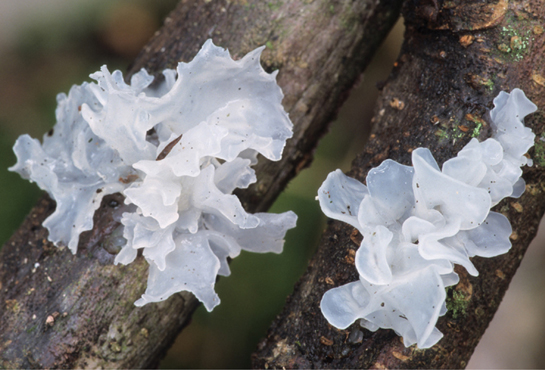
 Tremella fuciformis (photo credits 1.163)
Tremella fuciformis (photo credits 1.163)
Ethanol extracts of the fruiting body induce apoptosis in lung carcinoma cell line A549 (Chen, N. Y. et al. 2008).
It increases production of interferon and interleukin-2, as well as macrophages; increases natural killer cells and effectiveness of antibodies; and reduces the rate at which cancers spread, by angiogenesis.
The fungus has been shown in clinical trials to benefit patients with hepatitis B. After thirty-six months, the cure rate was better than 90 percent, and between 50 to 75 percent after only three months of treatment.
Extracts kill cervical cancer cells and sensitize the uterus and cervix to radiation treatment, increasing the effectiveness of the therapy. It also prevents leukopenia, a common side effect of radiation and chemotherapy.
Various Tremella species contain glucuronoxylomannan acids that stimulate vascular endothelial cells; have anti-radiation effects; stimulate hematogenesis; and possess anti-diabetic, anti-inflammatory, anti-allergenic, hypocholesterolemic, and liver-protectant qualities.
Tremella aurantia, for example, decreases glycemia in insulin-dependent diabetes, due to an active compound TAP, or Tremella acidic poly-saccharide (Kiho et al. 2000).
Studies indicate their use in immune-deficient conditions, as well as prevention of senile degeneration of micro blood vessels. A recent study found a 70 percent ethanol extract to be active against prostate cancer cell lines LNCaP and PC-3, through G2/M phase cell cycle arrest (Kiho et al. 2010).
One study found mushroom extracts of benefit in chickens infected with Eimeria tenella.
Black witch’s butter shows 90 percent inhibition of sarcoma 180 cancer cell lines (Ohtsuka et al. 1973).
Dacrymenone, an extract from the Dacrymyces species, is weakly antifungal and antibacterial. Another compound, VM 3298–2, is cytotoxic and antifungal (Mierau et al. 2003). VM 3298–2 is cytotoxic against human colon adenocarcinoma cells lines, with IC50 of ten micrograms per milliliter and five micrograms per milliliter against HL-60 and L1210 cells respectively.
Apricot jelly (T. hevelloides) shows 100 percent inhibition of both sarcoma 180 and Ehrlich carcinoma cancer cell lines (Ohtsuka et al. 1973).
Black witch’s butter essence supports the spiritual confrontation with negative experience to the blockage of their own spirituality.
—MARIANA
Yellow witch’s butter essence is for young people who react defiantly. It helps dissolve rigid attitudes and opens up the possibility partner is also opening.
—MARIANA
Tremella nostoc, or T. coelifolium, is green-like and grows in wet areas. It was known as sky fall by Linnaeus, and thought to originate from fallen stars.
Tremella Nestoe. A curious gelatinous plant, once celebrated among alchemists, who used it in their search for the philosopher’s stone and the universal panacea, had defied all botanical research even up to a century ago. The botanists could not analyze it or classify it; it was variously assumed that it was not a plant at all but the droppings of herons which had fed upon frogs, or even, by the old alchemists, that it was an emanation from the stars.
—CLAIRE POWELL
Glucuronoxylomannan is a high molecular substance useful for skin cosmetics, helping to retain skin moisture and giving skin protection, flexibility, and flattening effect. It is free of pH dependence and forms a film when dried in a state attached to skin or hair. It has application for cleansing and massage creams, facial washes, eau de toilette, and hair preparations.
Three to six grams: Soak the dried fungi in water to hydrate, or use fresh. Simmer in water for six to eight hours, until pasty, and then add honey. Drink for ten days, then take three days off. It is good for colds, flu, asthma, bronchitis, and general debility, as it is an immunomodulator.
Be careful using Tremella for coughs resulting from cold wind, due to the mushroom’s cooling nature.
Pseudohydnum gelatinosum
(JELLY TONGUE)
(TOOTHED JELLY FUNGUS)
Jelly tongue is a gelatinous, hydnum-like toothed fungus common to coniferous forests in colder climates. It can be eaten raw or cooked. David Arora says this mushroom is one of his fifty-five favorite fleshy fungal fructifications. He says in Mushrooms Demystified that “they are unique, and look funnier than they do fungal—in fact, it is hard to take them seriously!”
The inhibition rate against sarcoma 180 and Ehrlich carcinoma cell lines is 90 percent (Ohtsuka et al. 1973).
Jelly tongue (P. gelatinosum) essence helps us center ourselves and to concentrate, keeping us in balance. It strengthens our cellular structure, preserving our power (and our body heat) at the center of our being rather than allowing it to dissipate and be wasted.
—KORTE PHI
Polyporus biformis
Hirshioporus biformis
H. pargamenus
P. pargamenus
(PURPLE TOOTHED POLYPORE)
(PARCHMENT BRACKET)
T. abietinum
H. abietinus
Polyporus abietinea
(VIOLET PORED BRACKET FUNGUS)
(VIOLET FIR BRACKET FUNGUS)
(FIR POLYPORE)
T. fuscoviolaceum
T. hollii
H. fusco-violaceus
P. abietinus var. irpiciformis
Both bracket fungi are common, the former growing mainly on deciduous trees, and the latter on conifers.
Purple toothed polypore has a pore surface that is violet to bluish, becoming more tooth-like with age.
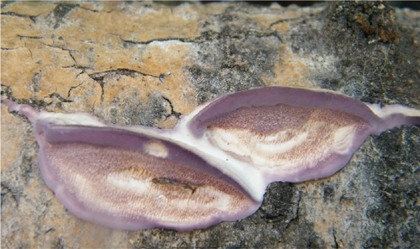
 Trichaptum biforme
Trichaptum biforme
T. abietinum is similar, but smaller and thinner, with a whitish, hairy cap and purple underside.
The Thompson First Nation of B.C. used this fungus, called owl wood, or kalulaa’iuk, and its spore powder as a rub to give strength to young men.
Violet pored bracket fungus shows activity against E. coli and Staphylococcus aureus bacteria (Ohtsuka et al. 1973).
Purple toothed polypore has been studied and found to possess antitumor activity. It has been found in clinical studies to possess anti-neoplastic activity (Jong and Gantt 1987).
The closely related T. fuscoviolaceum has been shown to inhibit tumors, with an inhibition rate against sarcoma 180 of 45 percent (Ohtsuka et al. 1973).
Bruno Boulet, in his beautiful book on polypores of Quebec, mentions the use of purple toothed fungi as a cold-weather mycoremediator of PCPs, which are organochlorine toxics. He also mentions the use of Irpex lactius and Diplomitoporus species. This is an area of great interest, helping clean up our environment by using mycelium power in cold climates.
T. ponderosum
Armillaria ponderosa
(PINE MUSHROOM)
(WHITE MATSUTAKE)
It is no dream!
Matsutake are growing
On the belly of the mountain
—SHIGETAKA
Matsutake:
From the depth of the pine forest,
The voice of the hawk
—KOYA
Tricholoma is Greek meaning “with hair on the edge or lump.” Magnivelare is Latin meaning “with big veil.”
This is the highly prized pine mushroom, very closely related to the matsutake (A. matsutake) of Japan.
Today, in Tokyo, a perfect specimen of the fresh T. matsutake mushroom (a variety that grows natively in Japan) can fetch up to $113 per pound. It has a sweet smell, reminiscent of garden cress (Lepidium sativum).
Every year, mushroom pickers in Alberta rush to the beds of reindeer moss under older jack pine for our related delicacy. It fetches a good price, especially for fresh, when it has good taste, and a pleasant fresh, spicy odor. Some compare the scent to cinnamon and others to fresh watercress. Arora suggests calls it reminiscent of dirty socks with a hint of cinnamon. It is, however, a mycoaccumulator of arsenic at rates of twenty-two times concentration, so care must be taken as to where it is picked.
It is sometimes mistaken for A. caligata, which has a cinnamon odor, crossed with alpha thujone (think wormwood or sage).
It is responsible for the fifth flavor (in addition to bitter, sweet, salty, and sour) which the Japanese call umami or, roughly translated, “deliciousness.”
This mushroom represents a sizable income for some residents, and others who travel to the pine forests for the annual harvest, with prices in the range of $10 to $15 per pound for prime specimens.
The wild mushroom is picked in China, where it is known as songron or songkuomo, and exported to Japan.
More than six thousand tons of raw mushrooms, worth more than $82 million, were exported from North America in 1996 alone. The worldwide trade is now believed to be worth at least several billion dollars annually, but that is dependent on worldwide economy and availability from Asian sources.
Retail prices of up to $113 per pound have been obtained in Japan, but not in recent years. Note that there are seven different grades, ranging from grade one, with tight buttons more than six centimeters long and with no partial veil evident, to grade seven, which are wormy but still firm.
It is a culinary waste to saute these mushrooms, as the unique aroma is lost. Instead, slice thinly, salt lightly, and then grill them until very slightly brown. They will be chewy and most aromatic.
I. H. Cho et al. (2006) have characterized the aroma active compound in raw and cooked pine mushrooms.
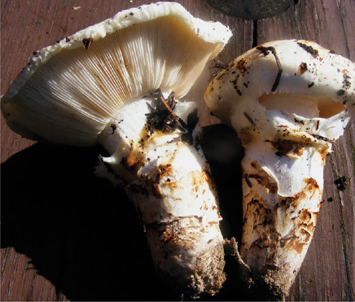
 Tricholoma magnivelare
Tricholoma magnivelare
A Japanese company has developed a synthetic essence of matsutake that can be poured over ordinary mushrooms to allow the diner to imagine he is eating the real thing. Methyl cinnamate is a major constituent of this essence.
Pine mushroom has been used as a remedy for difficult labor, acute gastritis, fevers, and convulsions. It is also used to treat tonsillitis and as a vermifuge.
Scientists have been studying the mushroom for its antitumor properties. One study found matsutake had a sarcoma 180 tumor-inhibition rate of 91.8 percent, and a cure rate in mice of 55 percent, very similar to shiitake. The inhibition rate for Ehrlich carcinoma is 100 percent.
Matsunaga et al. (2003) found mycelium active against colon cancer cells.
A novel immune-modulating alpha-glucan has been identified from the mycelium (Hoshi et al. 2005).
One study identified a polysaccharide fraction that is immune stimulating and increases production of NO and TNF-alpha. Another found a novel antitumor protein specific to inhibition of SV-40 and the human papilloma virus, believed to contribute to increased risk for cervical cancer.
Research found an alpha-glucan fraction inhibited growth of both primary and metastatic tumors.
Earlier work by same author suggests benefit against fibrosarcoma.
Another study found that the mycelium enhanced recovery of natural killer cell activity in mice.
The mycelium has been found to exert immune-modulating effect (Hoshi et al. 2005). They cultured T. matsutake in tanks, and found that the mycelial preparation, named CM6271, given orally, recovered natural killer cell activity and serum 1L-12 levels that had been reduced by stress. It showed antitumor activity against fibrosarcoma and prevented formation of precancerous lesions induced in the colon. The molecule was found distributed in M cells of intestinal Peyer’s patches one hour after ingestion.
A more recent article by same author confirmed localization of a single peak fraction, MPG-1, in Peyer’s patches, mesenteric lymph nodes, and the spleen, as well as promotion of iL-12 p70 production and natural killer cell activity (Hoshi et al. 2008).
Not only was the immune system stimulated through Peyer’s patches, the fraction was also taken into the blood and stimulated the systemic immune system. The mode of action is different than that of beta-D-glucans, on enhancement of antitumor or anti-infectious activities.
Hyun-Woo Lim et al. (2007) identified anti-inflammatory properties due to inhibition of nitric oxide production, as well as antioxidant activity.
Jong Hyun Kim et al. (2008) found cultured beta-glucan stimulates the immune system due to NF-kappaB activation.
Earlier work found the fruiting bodies show antitumor activity against fibrosarcoma.
Ryong et al. (1989) found anti-atherogenic and anti-atherosclerotic properties in A. matsutake extracts.
Tricholomic acid is a flavor enhancer that excites the central nervous system. In larger doses, it is lethal to flies. Jonathan Ott, in his wonderful book Pharmacotheon, mentions a “single fly even squeezed through the tiny opening of the screw-cap vial in which the small amount of tricholomic acid solution was kept, and there met his death!”
The structural analog, glutamic acid, in the form of monosodium glutamate (MSG), is a neurotoxin. It is associated with headaches, numbness and tingling, nausea, dizziness, and other symptoms, especially in those people deficient in B6.
The compound is used in many foods for flavor enhancement, and although considered safe for humans, it was voluntarily removed from baby food in 1970, when it was found that the amount of glutamate in a jar of baby food was enough to induce damage in an immature brain.
Matsutake (A. matsutake) owes its pine-like fragrance to alpha- and beta-pinene, cembrene, and S-matsutake alcohols. It also contains amino acids and methyl cis-a-methyl cinnamate, which aids in moisture retention and 2-octen-1-ol, found in many mushrooms, which stimulates peripheral circulation. Matsutake is believed to be an important dietary item for the musk deer, which is the source of the rare and expensive natural musk. This is identical in structure and chemistry to the pheromones secreted by the human male, and used in a number of cosmetic and perfumery items. Various Song Yi mushroom extracts, from water to ethanol to ceramide blends, are available in Asia.
The fungus was used traditionally in Korea in a decoction, steeped overnight, and then applied as a facial wash to remove dark skin spots from sun damage and to tighten skin wrinkles. An alcohol extract rich in songyic acid is of great interest in Korea as a skin whitening agent and alternative to kojic acid.
Matsutake is recommended for facial creams and lotions for sensitive skin, moisturizing products, and for stimulating bath and shower products. It can be found in products like Amore Pacific Treatment Cleansing Lotion.
Matsunaga et al. (2003) have developed a method to mass-produce mycelium of matsutake for functional food application.
In parts of Japan, the mushroom is threatened with extinction due to nematodes attacking the root hairs of pine trees, and attempts at cultivation have met with limited success.
One study successfully inoculated pine trees with T. matsutake. This technique may be of value to creation of a sustainable pine mushroom industry in the Pacific Northwest.
(STREAKED TRICHOLOMA)
(PRETENTIOUS TRICHOLOMA)
(STICKY GRAY TRICH)
T. populinum
(THE SANDY)
(COTTONWOOD MUSHROOM)
Streaked Tricholoma is known in Japan as shimofurishimeji, in Poland as siwki, and in Sweden as streckmusseron.
The gills and stalks are tinged a greenish yellow. It is commonly found under pine.
It is a perfectly edible fungi if you manage to find it before the insects do.
Tricolomic acid, as previously mentioned, is a flavor enhancer that excites brain neurons.
The monoterpene volatiles responsible for streaked Tricholoma’s aroma have been identified in work by Breheret et al. (1997) and include alpha-pinene, and beta-phellandrene.
Cottonwood mushroom is also called “the sandy” in reference to its common home of sandy soil beneath cottonwood trees near a source of water. The Shuswap call it smetl’ aka, the Thompson meaqi, the Okanagan-Colville, petl’kin, and the Lillooet, meix qin.
It grows in clumps under various hardwood trees and has a sweet, mealy scent similar to sweet bedstraw or cucumber. It is a popular edible mushroom of First Nations in the interior of British Columbia. The fungi were traditionally strung and dried for winter use, but also eaten raw or cooked.
The First Nations people of British Columbia used the juice from cooking cottonwood or pine mushrooms to wash infants, which was believed to help them grow up strong and independent, like a mushroom that can push through rocks and logs as it grows.
 Tricholidic acid and tricolomic acid.
Tricholidic acid and tricolomic acid.
 The mushrooms are 94 percent water, but contain significant content of iron 0.67 percent, copper 0.51 percent, zinc 0.45 percent, magnesium, chromium, and manganese.
The mushrooms are 94 percent water, but contain significant content of iron 0.67 percent, copper 0.51 percent, zinc 0.45 percent, magnesium, chromium, and manganese.
These mushrooms have been found to contain ergosterol and the recently discovered and novel steroid portensterol.
This sterol is found in the toxic Clitocbye nebularis and choice edible blewit (C. nuda).
They contain a number of other sterols and the triterpenoid tricholidic acid.
Methanol extracts indicate antioxidant and free radical-quenching activity.
An extract derived from dimethyl sulfoxide (DMSO) shows activity against Bacillus subtilis and B. cereus, as well as Cryptococcus neoformans associated with cryptococcosis (Barros et al. 2007a).
It shows inhibition of sarcoma 180 and Ehrlich carcinoma cancer cell lines by 70 percent and 60 percent respectively.
Pine mushrooms are a source of polyprenols, not usually associated with mushrooms. Kukina et al. found what they called “fungoprenols” in T. populinum, Armillaria mellea, and Lycoperdon perlatum (Kukina et al. 2005). They all contain predominately acetylated polyprenols. Their use and function is undetermined.
Eating the mushroom led to the regression of severe allergic symptoms in one patient with thromboangitis obliterans and in another with urticaria.
Various ergosterol peroxides have been identified.
(BURNT TRICHOLOMA)
(BITTER TRICHOLOMA)
T. vaccinum
(SCALY TRICHOLOMA)
(RUSSET SCALY TRICH)
T. virgatum
(FIBRIL TRICHOLOMA)
T. flavovirens
T. equestre
T. auratum
Agaricus equestre
A. flavovirens
(MAN ON HORSEBACK)
(SADDLE SHAPE TRICH)
(CANARY TRICH)
(YELLOW KNIGHT)
T. aurantium
(SLIMY ORANGE TRICH)
(VEILED TRICH)
T. aggregatum (see Lyophyllum decastes)
T. nudum (see Lepista nuda)
 Tricholoma equestre (photo credits 1.166)
Tricholoma equestre (photo credits 1.166)
Ustale is Latin meaning “burnt cinnabar,” a pigment. Vaccinum is related to “cow-like color.” Aurantium means “orange.” Virgatum means “streaked.” Flavovirens suggests “golden yellow spring,” and equestre pertains to “a horse.”
Burnt Tricholma has the odor of wild licorice, and is found under deciduous trees.
The largest specimen in the world is located in Mushroom Park in the tiny village of Vilna, Alberta. Weighing more than seventeen thousand pounds and standing nearly twenty feet high, this replica sculpture of three burnt Tricholoma was built in 1993 and is a popular destination for tourists and mycophiles. Unfortunately, its name is misspelled as T. uspale, and it is wrongly suggested that the mushroom was a choice edible enjoyed by the Ukrainian settlers of the area. In fact, burnt Tricholoma is a gastric irritant, containing the toxin ustalic acid.
It has a high protein content, from 30 to 50 percent.
Fibril Tricholoma has a grayish cap, with distinctive pointed knob. It is found under spruce and jack pine in late summer.
These two Tricholoma species are not recommended for eating, as they may cause diarrhea and vomiting.
Man on horseback, known to my Polish in-laws as gaski, is, on the other hand, considered by some to be a delicious edible mushroom. In the Middle Ages, it is said that French knights reserved pride of place for this mushroom at their tables, and left the less desired bovine bolete for the peasants. It is widely sold in European markets. Man on horseback is believed by some authors to relate to General Ernest Berlanger, a dictator of France, who almost always appeared in public on horseback.
One study suggests avoiding this mushroom, as it may cause fatal rhabdomyolysis. This is a breaking down of skeletal muscles that may lead to kidney failure. It is a good thing I never enjoyed the flavor.
The poisoning was the result of a rather large quantity of mushrooms. One found the same effect in rats using Boletus edulis, so something is amiss. Later work by the same researchers reported myocardio and hepatoxic effects from T. equestre when consumed by mice for long periods of time. The mushrooms were freshly frozen and not cooked. Cook all mushrooms, even for your pet rodents!
Slimy orange Tricholoma is not considered an edible mushroom, which is too bad because the odor is cucumber-like. Helene Schalkwijk-Barendsen wrote that they smell like bulrush hearts, a rather apt description of the odor. They contain physcion, a nasty toxin. Personally, I don’t bother picking them, as to me the taste is rather rancid.
The related T. pardinum, or tiger Tricholoma, is found occasionally, but is poisonous! It can be mistaken for a white Tricholoma, but will cause severe gastroenteritis. Badalyan et al. (2001) found in laboratory studies that the fungus produced ill effects on the central nervous system of mice.
Dirty or earthy Tricholoma (T. terreum) is edible, not choice, but certainly worth picking and cooking. It has an earthy flavor and odor that is unpleasant to some, and favored by others. Optimal storage is obtained by submerging it in boiling water for six minutes and then putting it quickly into cold storage.
 T. equestre: tryptophan, serotonin, tryptamine, and flavomannin-6,6’-dimethyl ether.
T. equestre: tryptophan, serotonin, tryptamine, and flavomannin-6,6’-dimethyl ether.
Tricholoma gambosum, also known as T. georgii and Calocybe gambosa, is used in China to treat measles and sick children feeling agitated and upset.
Inhibition rate against both sarcoma 180 and Ehrlich carcinoma is 90 percent.
Tricholoma ustale, T. vaccinum, and T. virgatum have shown inhibition rates against sarcoma 180 and Ehrlich carcinoma of 70 to 90 percent.
The related T. robustum shows 100 percent inhibition of both; T. sejunctum shows 90 percent inhibition of both, and T. fulvum 80 percent and 70 percent respectively (Ohtsuka et al. 1973).
Methanol extracts of T. equestre contain a sterol that stimulates the enzyme alkaline phosphatase in mouse osteoblasts, or bone cells. High levels of this enzyme activity are associated with increased proliferation and differentiation of osteoblasts and prevention of osteoporosis. This sterol protected osteoblasts from apoptosis that normally occurs in serum starvation.
The novel compound flavomannin-6,6’-dimethyl ether shows potent inhibition of human adenocarcinoma colorectal Caco-2 cells, with arrest in the G0/G1 phase.
Chloroform extracts of T. aurantium fruiting body show weak antibacterial activity against E. coli, Staphylococcus aureus, and S. epidermidis, but strong activity against Bacillus subtilis. An ethyl acetate extract showed weak activity against Pseudomonas aeruginosa. Mycelium extracts were active against E. coli and S. aureus (Yamac and Bilgili 2006).
A novel polysaccharide-bound protein (PSPC) has been isolated from T. mongolicum and shown to activate both lymphocytes and macrophages from BALB/c mice, and yet it shows no direct cytotoxic activity against fibroblasts, hepatoma, or choriocarcinoma cells.
Le Li et al. (2005) found a lectin from these edible mushrooms stimulates gene expression of immunomodulating cytokines in mice.
Another PSPC purified from T. lobayense inhibits growth of sarcoma 180, with no signs of in vivo toxicity.
It appears that immune cells are responding to PSPC through gene expression and production of immune-modulating cytokines that may mediate immunopotentiation of this agent in vivo.
White Tricholoma (T. album) myco-accumulates titanium.
The mycelium of the related T. panaeolum (Clitocybe fasiculata), grown in fermentation tanks, shows inhibition of malignant adenoma 755 in mice (Espenshade and Griffith 1966; Gregory et al. 1966).
Tricholomalides A-C identified by Tsukamoto et al. (2003) show significant induction of neurite growth.
Sulphur knight (T. sulphureum) is a poisonous species that nonetheless inhibits sarcoma 180 and Ehrlich carcinoma cells by 90 percent and 80 percent respectively (Ohtsuka et al. 1973).
Tricholoma rutilans
(PLUMS AND CUSTARD)
(VARIEGATED MOP)
T. platyphylla
Megacollybia platyphylla
Oudemansiella platyphylla
(BROAD GILL)
Plums and custard mushroom is edible, but not highly recommended, unless you like the taste of rotten wood. With its reddish hairs on yellow caps, and bright yellow gills, plums and custard mushroom is a striking mushroom. It has a musty smell and is often found on rotting pine or spruce stumps and deadfall in the boreal forest. It is sold in markets in central Europe.
Broad gill is widespread and common on logs and underground wood. It has a white spore print. It is not edible, and can cause abdominal pain, vomiting, diarrhea, and muscle spasms.

 Tricholomopsis rutilans (photo credits 1.167)
Tricholomopsis rutilans (photo credits 1.167)
 Fomecin B, steryl esters with a polyhydroxylated ergostane-type nucleus, and two hexynoic and hexenoic acids.
Fomecin B, steryl esters with a polyhydroxylated ergostane-type nucleus, and two hexynoic and hexenoic acids.
Fomecin B has been found to be antagonistic to various cancer cell lines.
Koch et al. (1998) looked at ethanol extracts of both the fruiting bodies and mycelium of plums and custard mushroom. They found the extract reduced the binding of lipopolysaccharide and the release of mediators. At a concentration of one hundred micrograms per milliliter, the extract inhibited more than half of the LPS binding. It also decreased LPS-induced release of interleukin 1 and tumor necrosis factor alpha.
New steryl esters with a polyhydroxylated ergostane-type nucleus have been identified (Wang, F. and J. K. Liu 2005).
Two hexynoic and hexenoic acids have been identified in the fruiting body (Hatanaka and Niimura 1972).
One study found this species to possess the highest antioxidant levels of several species tested.
Pujol et al. (1990) found fungal extracts of broad gill to be active against Candida albicans, C. tropicalis, and Aspergillus fumigatus.
Inhibition rates of 80 percent against sarcoma 180 and 90 percent against Ehrlich carcinoma have been noted in mice studies (Ohtsuka et al. 1973).
(TOTALLY TEDIOUS TUBARIA)
David Arora says that this species is “your quintessential ‘LBM [little brown mushroom],’ as boring as it is ubiquitous and innocuous as it is inconspicuous.… To say more about it would do the more interesting mushrooms in this book an injustice.” It is found in wood-chips and lawns.
It shows inhibition of sarcoma 180 at 80 percent and Ehrlich carcinoma 90 percent (Ohtsuka et al. 1973).
(BURIED STALKED PUFFBALL)
Tulos is Greek meaning “tumor.” Stoma means “stomach.” Simulans is Latin meaning “imitating” or “simulating.” Hence, “imitating stomach tumor.”
This fungus and desert drumstick (Battarraea stevenii) are the only two local species of the Tulostemataceae family in my part of the world.
It is fairly common across western North America, found on sandy soil. The mature mushroom is inedible.
Tulostoma simulans was used by various native tribes for its symbolism, in ceremonies and displays of art.
The related T. obesum exhibits significant antibacterial activity (Al-Fatimi et al. 2005).
T. alutarius
Boletus alutarius
B. felleus
(BITTER BOLETE)
T. plumbeoviolaceus
(GRAY VIOLET BOLETE)
This mushroom looks similar to the king bolete and is found under mixed or coniferous woods. It has a pink spore print and pink billowed tubes. Unlike the king bolete, however, the taste is very bitter, like gall.
The related T. plumbeoviolaceus is a bitter tasting violet-brown species.
 T. felleus: 2-butyl-1-azacyclohexane iminium salt, N-y-Glutamul boletine, and tylopilan.
T. felleus: 2-butyl-1-azacyclohexane iminium salt, N-y-Glutamul boletine, and tylopilan.
 T. plumbeoviolaceus: two seco-ergosterols, tylopiol A and B, allitol, and ergosta-7,22-dien-3beta-ol uridine.
T. plumbeoviolaceus: two seco-ergosterols, tylopiol A and B, allitol, and ergosta-7,22-dien-3beta-ol uridine.
Slane et al. (2004) found the fungus inhibited pancreatic lipase by 96 percent, and was the second highest of 110 macrofungi they tested.
A toxic principle, 2-butyl-1-azacyclohexane iminium salt, was extracted from Tylopilus species and found to exhibit moderate acute toxicity against ddY mice (Watanabe, R. et al. 2002).
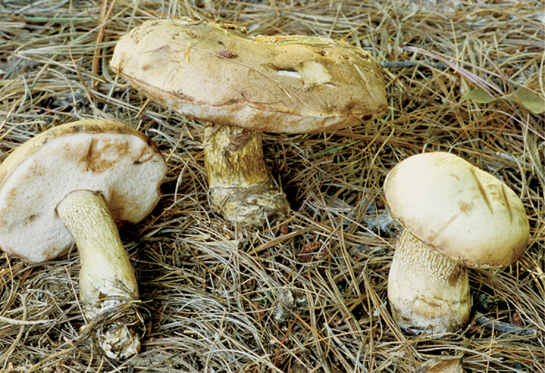
Tylopilus felleus (photo credits 1.168)
The compound N-y-glutamyl boletine exhibits moderate antibacterial activity.
Subcutaneous administration of a lycophilized preparation inhibited inflammation, but oral dosage did not produce significant results in work by Kohlmunzer et al. It is said to possess anticancer activity, due to its content of mucilage. This chemical is believed to stimulate the immune system and fight infection (Kohlmunzer et al. 1977).
The initial research was conducted in Poland and is now being followed up by a Japanese laboratory.
One study identified tylopilan, a beta-glucan chain cytotoxic to 180-TG Crocker tumor cells in vitro. A combination of tylopilan and Propionibacterium acnes injected in mice suggests that immune stimulation enhances the antitumor activity.
Early work by Ohtsuka et al. (1973) found an extract of the fruiting body inhibited both sarcoma 180 and Ehrlich carcinoma cell lines in mice by 100 percent.
The related T. plumbeoviolaceus contains two seco-ergosterols, tylopiol A and B, as well as allitol and ergosta-7,22-dien-3beta-ol uridine.
T. albellus
Leptoporus albellus
L. chioneus
Polystictus chioneus
Ungularia chionea
(WHITE CHEESE POLYPORE)
T. caesius
Postia caesia
Oligoporus caesius
(BLUE CHEESE POLYPORE)
T. fragilis
Postia fragilis
Oligoporus fragilis
(RUSTY CHEESE POLYPORE)
White cheese polypore is widespread on hardwood trees and is occasionally found on dead conifers. It is reminiscent of the oyster mushroom, except that it has pores instead of gills and the color is pure white.
Cadinane sesquiterpenes isolated from these fungi have been found to possess anti-HIV-1 activity. The potency is significant with an EC50 equal to three micrograms per milliliter (Liu, D.-Z. et al. 2007).
Early work by Hervey (1947) found that blue and rusty cheese polypore both show activity against Staphylococcus aureus. Earlier work by Robbins et al. (1945) found the same activity in white cheese polypore.
The related Irpex mollis (Spongipellis pachydon) also grows on conifers and has pores that become tooth-like with age. It exhibits activity against Staphylococcus aureus, cited above.
The related S. delectans (Polporus delectans), T. fumidiceps, T. guttulatus, T. balsameus, and T. galactinus showed moderate activity in the same study. The related T. stipticus, also known as T. immitis, shows significant activity.
Tyromyces subvermispora, now known as Ceriporiopsis subvermispora, is a white rot fungus that degrades lignin without significant damage to cellulose. Ceriporic acid is believed to be the important compound.
White cheese polypore was shown by Sasek et al. (1998) to be useful as a myco-degrader of synthetic dyes.
U. zeae
(CORN SMUT)
Corn smut is occasionally found on corn ears. In Mexico, it is known as huitlacoche, which is derived from the original Nahuatl name for the fungus, cuitlacoche, which translates literally as “sleeping excrement,” referring either to the hidden nature of the fungi within the husks, or the state of mind in sleep.
Early ethnobotanists may have been mistaken and this may refer to corn ergot, or Claviceps gigantea. Often referred to as diente de caballo, or horse’s tooth fungus, this ergot is hard, dry, and smelly and cannot be mistaken for food. Of course, it would have effects similar to rye ergot (see Claviceps).
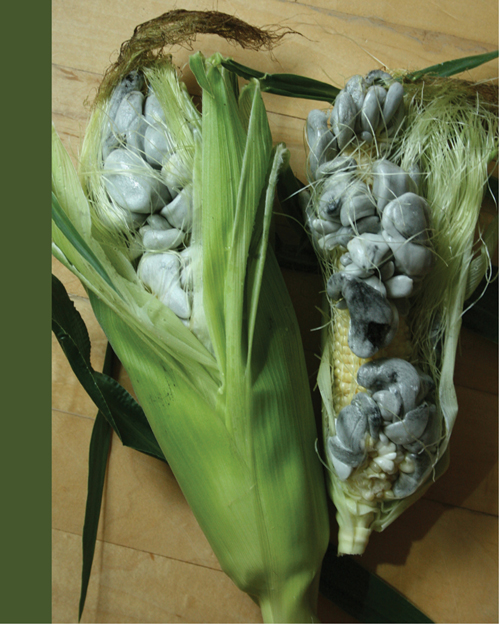
In Mexico, corn smut is eaten in tacos and other stir-fried dishes. It is ready to eat when it feels like a pear starting to ripen.
 Proteinase pumA and pumB, aminopeptidase pumAPE, and dipeptidylaminopeptidase pumDAP.
Proteinase pumA and pumB, aminopeptidase pumAPE, and dipeptidylaminopeptidase pumDAP.
The fungus is believed to prevent or cure hepatic or gastroenteric ulcers and relieve constipation. The spore powder is combined with brown sugar and used in cases of neurasthenia and infantile malnutrition.
A tincture is used to treat poor circulation to the brain, dizziness, impaired vision, and dull headaches at the top of the head. It is made with one part fresh fungus to ten parts 40 percent alcohol.
Ustilagic acid has been found to inhibit Candida albicans. The fungus inhibited the growth of sarcoma 180 in mice trials (Gregory et al. 1966).
Water extracts inhibit sarcoma 180 in white mice (Ohtsuka et al. 1973).
Ustilago maydis, or corn smut, is indicated in atonic (passive) uterine hemorrhages and threatened or habitual miscarriage. Nervous headaches from menstrual irregularity are common.
It is also indicated in heavy menstrual bleeding, in spotting and bleeding between menstrual periods, and in retroversion of the uterus. There may be ovarian pain during hemorrhage, or the cervix may bleed easily, with dark clotted blood that forms long black strings.
It can be used to treat alopecia or dry skin, small boils, eczema, and crusta lactea.
It can be specific to psoriasis, used internally and externally.
In the male, there is an uncontrollable desire to masturbate, with erotic fancies and amorous dreams. This is accompanied by a dull pain in the lumbar region, great despondency, and mental irritability.
Muscular debility with the sensation of boiling water along the back should be looked for. Muscular contractions, especially of the lower limbs, are another indication worth noting.
Dose: 3C tincture. The attenuation is prepared from the spores of the fungus, Ustilago zeae, which lives parasitically on the stalk, flower, and grains of the maize. The powdered spores are then tinctured at a ratio of one to ten in 90 percent alcohol.
(MILLET SMUT)
Ustilago crameri is a fungus that infects the spikelets of Setaria italica and other members of the genus. The spores have a thin, grayish membrane that later breaks open with buff-brown to olive-brown powder.
The fungus is used in traditional Chinese medicine for curing indigestion related to fidgeting and agitation.
Three grams of spores are mixed with honey and taken with water twice daily.
(WILD RICE SMUT)
This fungus is found growing on the shoots of wild rice.
The sori, or clusters of spores, grow within the young stems, causing the stem to swell with infection. In an early stage, it can be eaten as a delicious and tasty vegetable. To prepare it, slice the wild rice shoots and dry the slices in the sun. Cook the dried shoots as a soup, adding salt and vinegar.
It has been found useful as a diuretic and laxative. It is used to treat redness of the eyes, alcohol intoxication, and carbuncles.
(WHEAT SMUT)
Like rye, wheat spikes are susceptible to ergot infestation. Ustilago nuda is a common spore mass on wheat and barley. It is mild in nature and tasteless.
In traditional Chinese medicine, it is noted for its diaphoretic and analgesic properties.
Pills made by collecting the sori are used to cure febrile and sensorial diseases, headaches, high fever with lack of perspiration, annoyance, and trismus, or grinding and gnashing of the teeth.
It is used to cure metrorrhagia, or in-between-period bleeding from the uterus.
X. radicata
Oudemansiella radicata
(ROOTED OUDEMANSIELLA)
This edible is found in mixed forests in summer and early fall. It is rarely found on the Pacific coast but has been identified in the midwestern plains.
 Oudenone and oudemansin X.
Oudenone and oudemansin X.
Oudenone strongly inhibits biosynthesis of enzymes associated with phenylalanine and tyrosine. One study found that this compound significantly lowers blood pressure. It appears to inhibit tyrosine hydroxylase in adrenal glands and reduce catecholamine levels in these glands as well as in the hearts of hypertensive animals.
Oudemansin X has been shown to possess antifungal properties (Anke, T. et al. 1990; Umezawa et al. 1995).
The inhibition rate against sarcoma 180 and Ehrlich carcinoma cell lines is 100 percent and 90 percent respectively (Ohtsuka et al. 1973).
Fermentation yields production of exo-polysaccharides (Zou et al. 2005).
Xylosphaera polymorpha
X. obovata
Hypoxylon polymorphum
Sphaeria polymorpha
(DEAD MAN’S FINGERS)
X. hypoxylon
Xylosphaera hypoxylon
(CANDLE SNUFF FUNGUS)
(STAGHORN FUNGUS)
The genus name starts with an X, but is pronounced Zylaria as in “sigh.”
Dead man’s finger is common and widespread near the base of rotting tree stumps.
Candle snuff is named for its shape, which is similar to the tool used for putting out candle flames. Other authors suggest the name is related to the manner in which spores are carried away in wind currents. This fungus is common year-round in the Pacific Northwest and has been reported to possess luminous mycelia.
Another name, staghorn, is related to its antler shape.
X. longipes is slimmer than X. polymorpha and is found on hardwood trees across North America.
In Ayurvedic folk medicine from India—where it is known as phoot doodh, literally “to gush milk”—dead man’s finger is used to promote milk flow after birth. The fruiting body is ground into a powder, blended with equal parts of sugar, and formed into pea-sized pills. These are taken twice daily before meals with cow’s milk for five days.
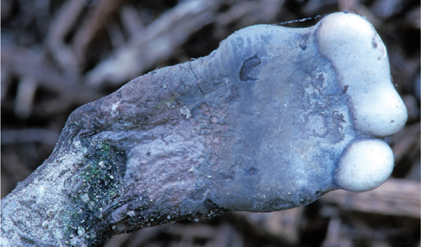
 Xylaria polymorpha (photo credits 1.170)
Xylaria polymorpha (photo credits 1.170)
The closely related X. nigripes sclerotia is used in traditional Chinese medicine for eliminating dampness, easing infant convulsions, and stopping heart palpitations. It is diuretic and sedative, promotes lactation, and stops blood loss related to the lungs or nose and after childbirth.
 X. polymorpha: piliformic acid, mannitol, globoscinic acid, globoscin and two cytotoxic cytochalasins, xyloketals A-E, xylarinic acids A and B.
X. polymorpha: piliformic acid, mannitol, globoscinic acid, globoscin and two cytotoxic cytochalasins, xyloketals A-E, xylarinic acids A and B.
 X. hypoxylon: cyochalasins, 19,20-epoxycytochalasin D, xylarone, and 8,9-dehydroxylarone.
X. hypoxylon: cyochalasins, 19,20-epoxycytochalasin D, xylarone, and 8,9-dehydroxylarone.
 X. longipes: xylaramide.
X. longipes: xylaramide.
Piliformic acid in the fruiting body shows moderate activity against KB and BC-1 cancer cell lines (Chinworrungsee et al. 2001).
The mushroom shows cytotoxic activity against human cancer cell line HL-60 through induction of apoptosis.
It also contains about 6 percent mannitol, a known diuretic compound.
Xyloketals A-E are potent acetylcholinesterase inhibitors, suggesting they may be useful in treating various brain memory conditions (Lin 2001).
Xylarinic acids A and B, isolated from the fruiting body, show significant antifungal effect against pathogenic fungi species including Fusarium oxysporium (Jan et al. 2007).
Xylaria species contain peptides that inhibit angiotensin-converting enzyme (ACE) (Vecchi et al. 2009).
Osmanova et al. (2010) found 170 azaphilone compounds in twenty-three genera that form vinylogous y-pyridines. They are particularly plentiful in Xylariaceae and Trichocomaceae members, and exhibit a wide range of natural antibacterial, antiviral, antifungal, anti-inflammatory, and antioxidant activity, as well as cytotoxic properties.
The mycelium of Xylaria species has been well studied and is marketed as a medicinal product. Studies show Wu Ling powder has a tranquilizing effect on the central nervous system. It contributes to the brain’s uptake of glutamic acid and GABA, and reinforces activity of glutamate decarboxylase. Sleep is improved and the abnormal stimulation of dopamine is reduced. A clinical trial of 2,372 patients with insomnia was carried out at more than fifty hospitals throughout China with a success rate of 91.1 percent.
It helps increase DNA synthesis of lymphocytes, improves macrophage activity to kill tumor cells, and stimulates production of cytokine IL-1. In this manner it helps restore body strength after chemotherapy, surgery, or radiation treatments.
The mycelium restores normal levels of erythrocytes and hemoglobin, and helps improve iron deficient anemia.
Hormonal imbalance is restored, including symptoms associated with menopause, prostate hypertrophy, and abnormal menstruation.
Both acute and chronic toxicity tests were negative.
Candle snuff contains cyochalasin, a compound that binds to actin, which is a protein found in muscle tissue. Espada et al. (1997) have identified several of these compounds.
Lin-Mei Shi and Zha-Jun Zhang (2007) identified 19,20-epoxycytochalasin D and its anti-tumor activity against P388 cancer cell lines.
Qinghong Liu et al. (2006) identified a lectin from the fresh fruiting body that possesses highly potent hemagglutinating, anti-proliferative, and anti-mitogenic activities. The lectin showed potent inhibition of tumor cell lines M1 and HepG2 with an IC50 of less than one micrometer. It is stable to thirty-five degrees Celsius (ninety-five degrees Fahrenheit). Earlier work by Liu found polysaccharides in the fruiting body that inhibit HIV reverse transcriptase.
Xylarone and 8,9-dehydroxylarone, a-pyrone derivatives, isolated from submerged culture of the mushroom, show cytotoxic activity.
Culture fluids from the related X. longipes contain xylaramide, a potent antifungal with activity against Nematospora coryli and Saccharomyces cerevisiae.
The related X. multiplex exhibits activity against Candida albicans (Boonphong 2001).
Xylaria species contain benzoquinone metabolites that show in vitro activity against Plasmodium falciparum (Tansuwan et al. 2007).
Follow-up work by Jimenez-Romero et al. (2008) found activity against chloroquinone-resistant strains of the organism associated with malaria. The compounds phomalactone and 5-hydroxymellein are involved.
Candle snuff essence is for those who hear what you say, but do not want to be involved. It will help you say NO! It is for those who have lost a loved one and are grieving. From death comes life. For nasal and digestive problems, inflammation and swelling.
—SILVERCORD
The fungi produce laccase in a complex medium based on tomato juice, while peroxidase activity is only detected when grown in soybean meal.
Xylaria is a one of the few ascomycetes species that decompose Manitoba maple.
A Swiss researcher, Francis Schwarze, made a replica of a Stradivari violin using maple wood treated with X. longipes. The mushroom nibbles away at the wood’s surface and thus reduces the density and improves the sound. Another musical use for fungi! Perhaps he should get together with the Czech composer Halek and make a true symfungy.
X. frustulosus
Stereum frustulatum
Thelephora frustulata
T. sinuans
Xerocarpus frustulosus
(CERAMIC FUNGUS)
(CERAMIC PARCHMENT)
Ceramic fungus is a flat-crusted fungus common to older, de-barked oak and other hardwoods. It creates localized pockets, known as partridge rot or honeycomb rot, that resemble broken pieces of tile.
 Frustulosin, frustulosinol, and torreyol.
Frustulosin, frustulosinol, and torreyol.
Nair and Anchel (1977) identified the antibiotic-like compounds frustulosin and frustulosinol. Activity against Bacillus subtilis, B. mycoides, and Staphylococcus aureus was noted in their work. Weak activity against Vibrio cholerae and Mycobacterium smegmatis was noted.
The sesquiterpene torreyol, also known as d-cadinol, has also been found in the wings of the male northern blue butterfly, Lycaeides argyrognomon, and may act as a pheromone (Lundgren 1975).